TP Link Technologies C3150 AC3150 Wireless MU-MIMO Gigabit Router User Manual Part 2
TP-Link Technologies Co., Ltd. AC3150 Wireless MU-MIMO Gigabit Router Users Manual Part 2
Contents
- 1. Users Manual Part 1
- 2. Users Manual Part 2
- 3. Users Manual Part 3
Users Manual Part 2
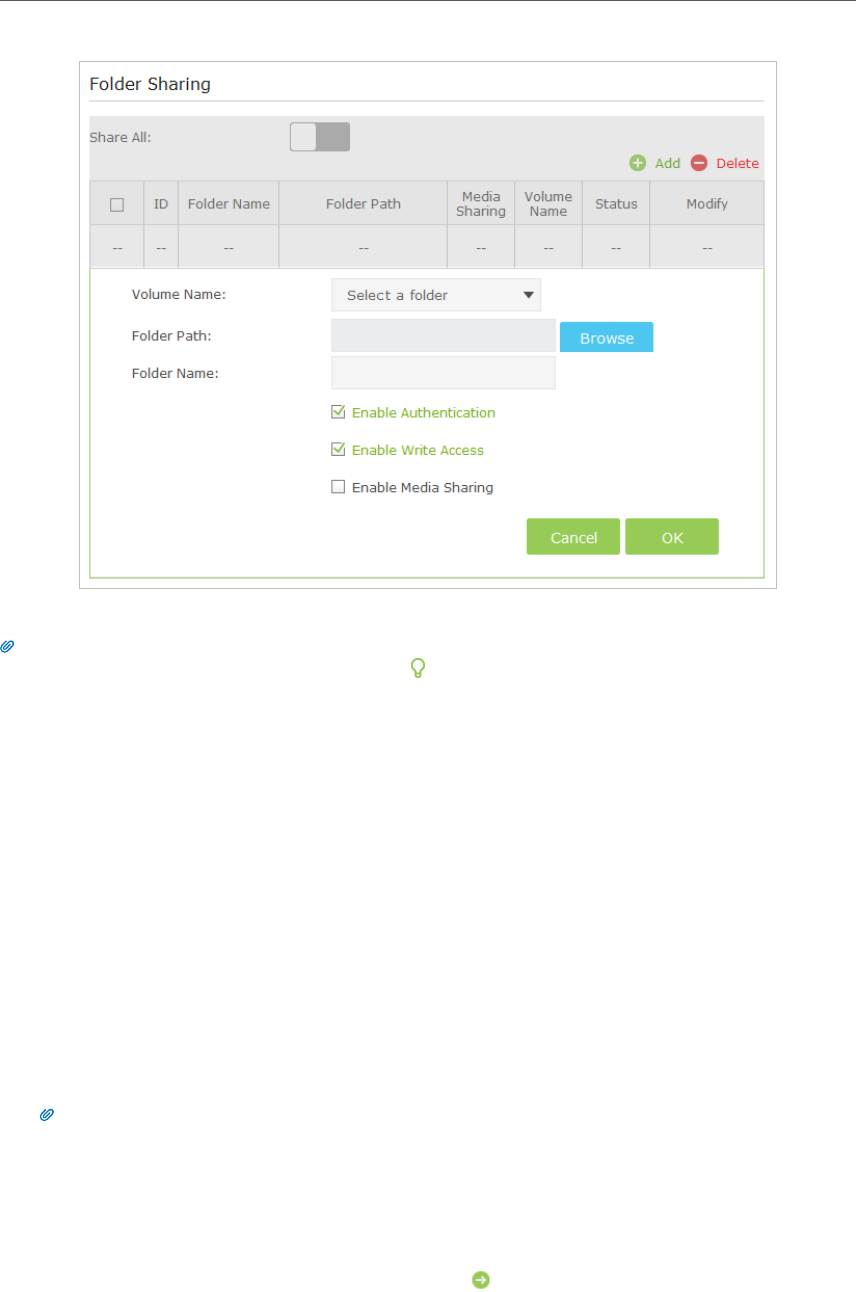
37
Chapter 6 USB Application
5. Click OK.
Tips:
The router can share 32 volumes at most. You can click on the page to detach the corresponding volume you do
not need to share.
6. 3. Media Sharing
The feature of Media Sharing allows you to view photos, play music and watch movies
stored on the USB disk directly from DLNA-supported devices, such as your computer,
pad and PS2/3.
6. 3. 1. Access the USB disk
1. Connect Your USB Disk
Insert your USB storage device into the router’s USB port directly or using a USB
cable. Wait several seconds until the USB LED becomes solid on.
Tips:
• If you use USB hubs, make sure no more than four devices are connected to the router.
• If the USB storage device requires using bundled external power, make sure the external power has been
connected.
• If you use a USB hard drive, make sure its file system is FAT32,NTFS.
• Before you physically disconnect a USB device from the router, safely remove it to avoid data damage: Go
to Advanced > USB Settings > Device Settings and click Safety Remove.
2. Play the Media on Your USB Disk
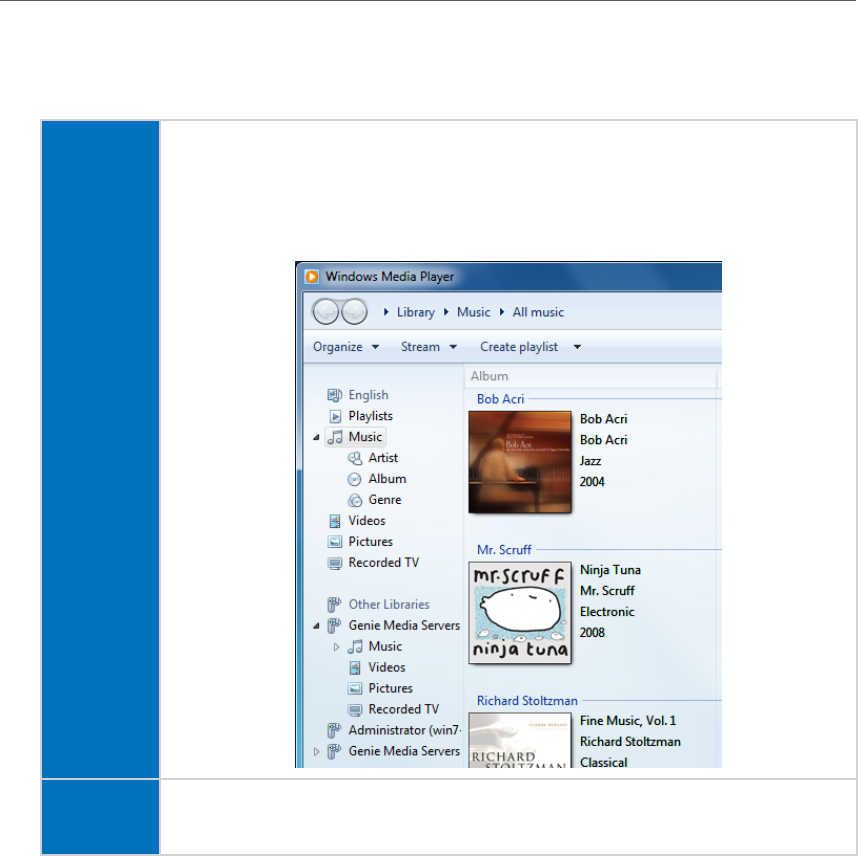
38
Chapter 6 USB Application
Now the DLNA-supported devices (such as your computer and pad) connected to
the router can detect and play the media files on the USB disks.
Windows
computer
1. Open the Windows Media Player.
2. Click the media server name (such as Genie Media Severs) under the list of Other
Libraries, then you can directly view photos, play music and watch movies that
you share on the USB disks.
Pad • Use a third-party DLNA-supported player.
6. 3. 2. Customize Your Settings
¾To Only Share Specific Content
By default, Share All is enabled so all content on the USB disk is shared. If you want to
only share specific folders, follow the steps below:
1. Visit http://tplinkwifi.net, then log in with the username and password you set for the
router.
2. Go to Advanced > USB Settings > Sharing Access.
3. Focus on the section of Folder Sharing. Click the button to disable Share All, then
click Add to add a new sharing folder.
4. Select the Volume Name and Folder Path, then enter a Folder Name as you like.
5. Select Enable Media Sharing and click OK.
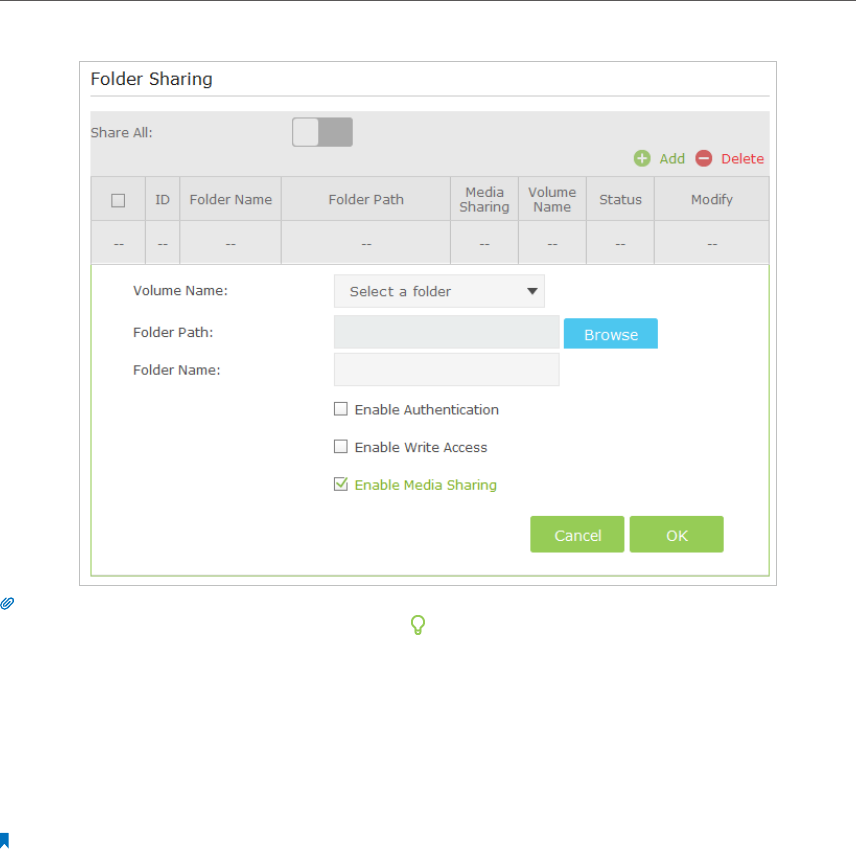
39
Chapter 6 USB Application
Tips:
The router can share 32 volumes at most. You can click on the page to detach the corresponding volume you do
not need to share.
6. 4. Printer Sharing
The feature of Printer Sharing helps you share a printer with different computers
connected to the router.
Note:
Printers unlisted may be incompatible with the router. You can check Printer Compatibility List to verify whether
your printer is supported by the router: http://www.tp-link.com/common/compatible/print-server/.
1. Install the Driver of the Printer
Make sure you have installed the driver of the printer on each computer that needs
printer service.
If you do not have the driver, contact the printer manufacturer.
2. Connect the Printer
Cable a printer to the USB port with the USB cable. Wait several seconds until the
USB LED becomes solid on.
3. Install the TP-LINK USB Printer Controller Utility
TP-LINK USB Printer Controller Utility helps you access the shared printer. Download
and install the utility on each computer that needs printer service.
You can get the utility from http://www.tp-link.com/app/usb/. PC Utility is for
Windows computer and Mac Utility is for Mac computer.
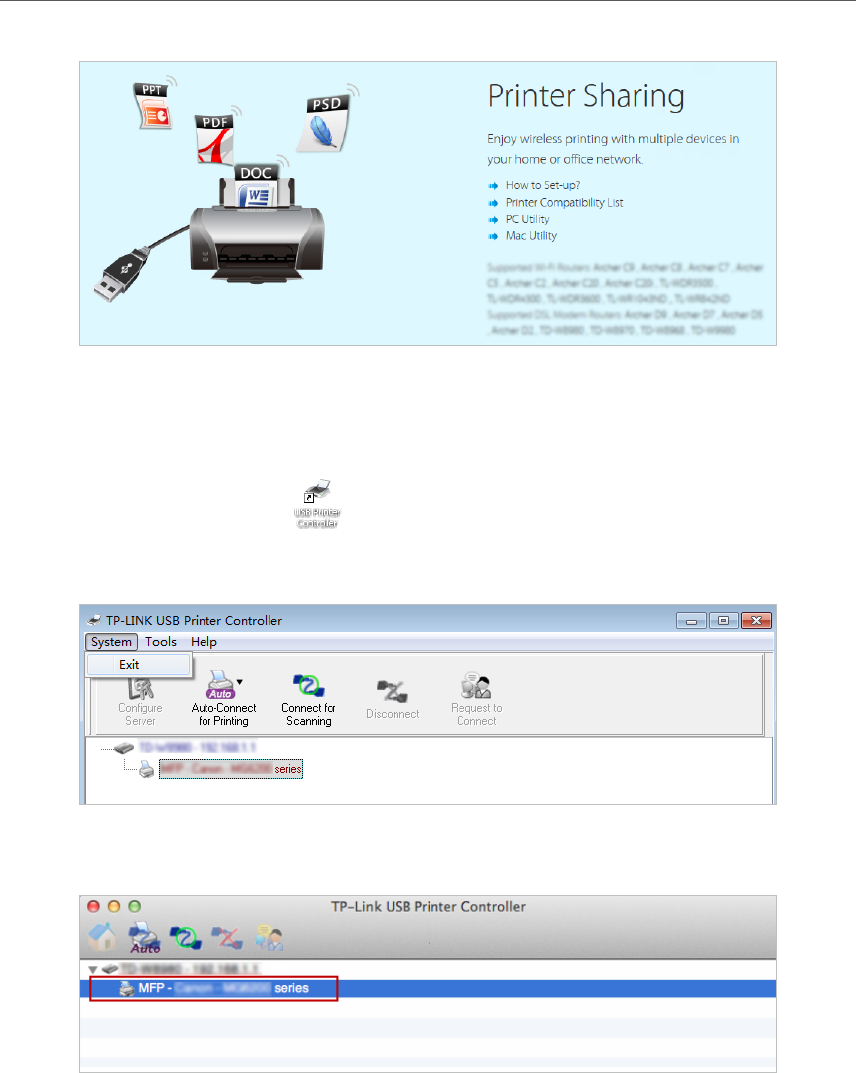
40
Chapter 6 USB Application
4. Access the Printer
You should set the shared printer as Auto-Connect Printer on every computer that
needs printer service.
1 ) Double-click the icon on your desktop to launch the USB Printer Controller.
2 ) Highlight the printer you share.
Windows
Mac
3 ) Click the Auto-Connect for printing tab to pull down a list, then select Set Auto-
Connect Printer.
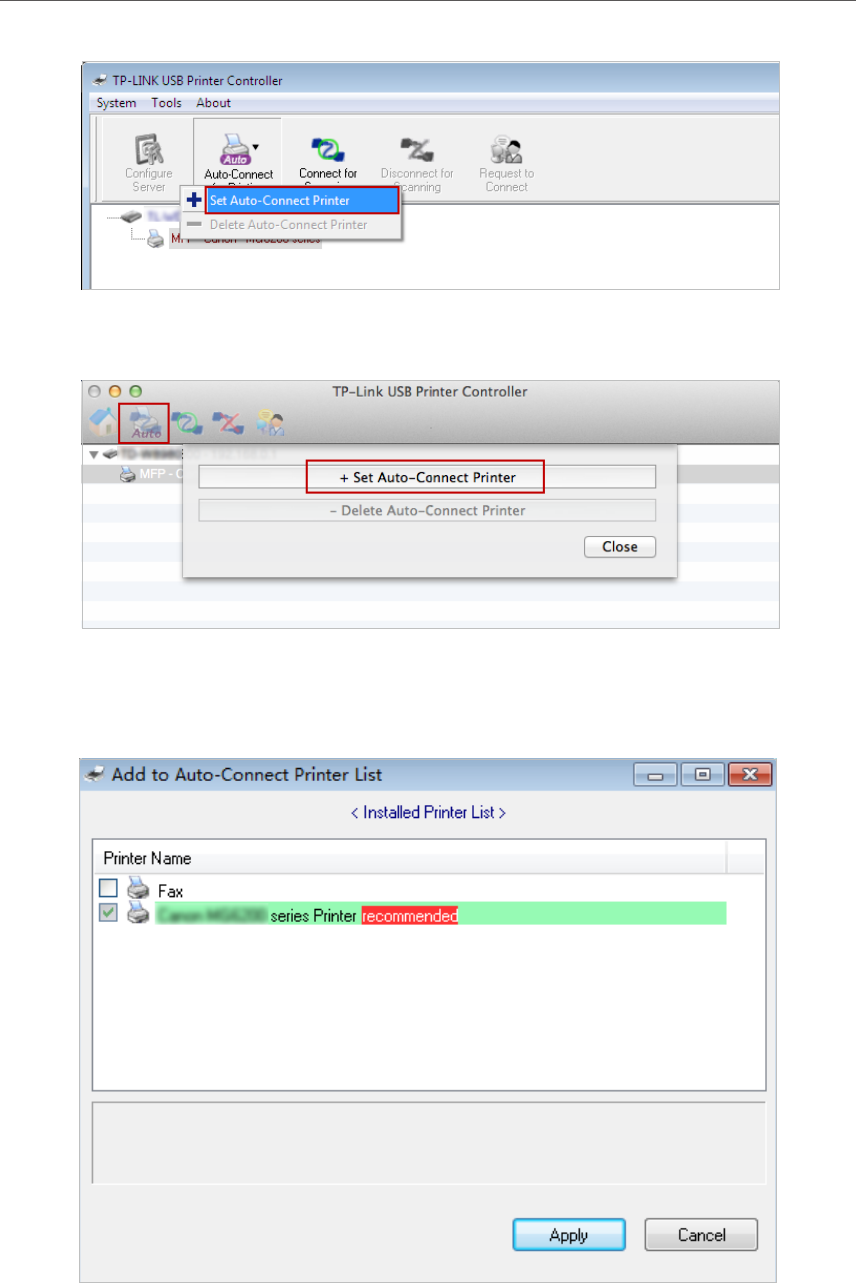
41
Chapter 6 USB Application
Windows
Mac
4 ) Select the printer you share, then click Apply.
Windows
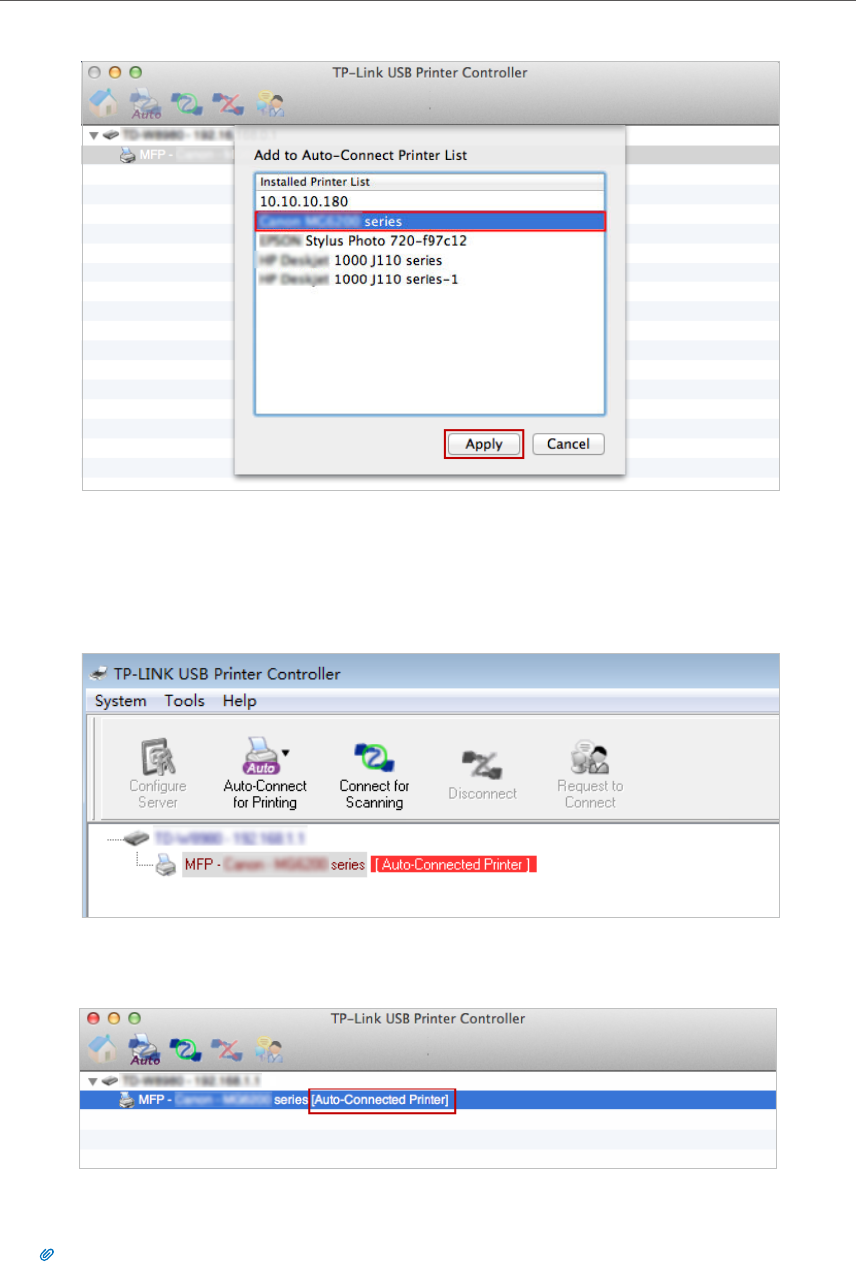
42
Chapter 6 USB Application
Mac
5 ) You will see the printer marked as Auto-Connect Printer. Now you can print
with this printer.
Windows
Mac
Tips:
The Print Server also allows different clients to share the scan feature of MFPs (Multi-Function Printers). To
scan with TP-LINK USB Printer Controller, right-click the printer and select Network Scanner. Then, a scanning
window will pop up. Finish the scanning process by following the on-screen instructions.

Chapter 7
Parental Controls
This function allows you to block inappropriate, explicit and malicious websites, and
controls access to specified websites at specified time.
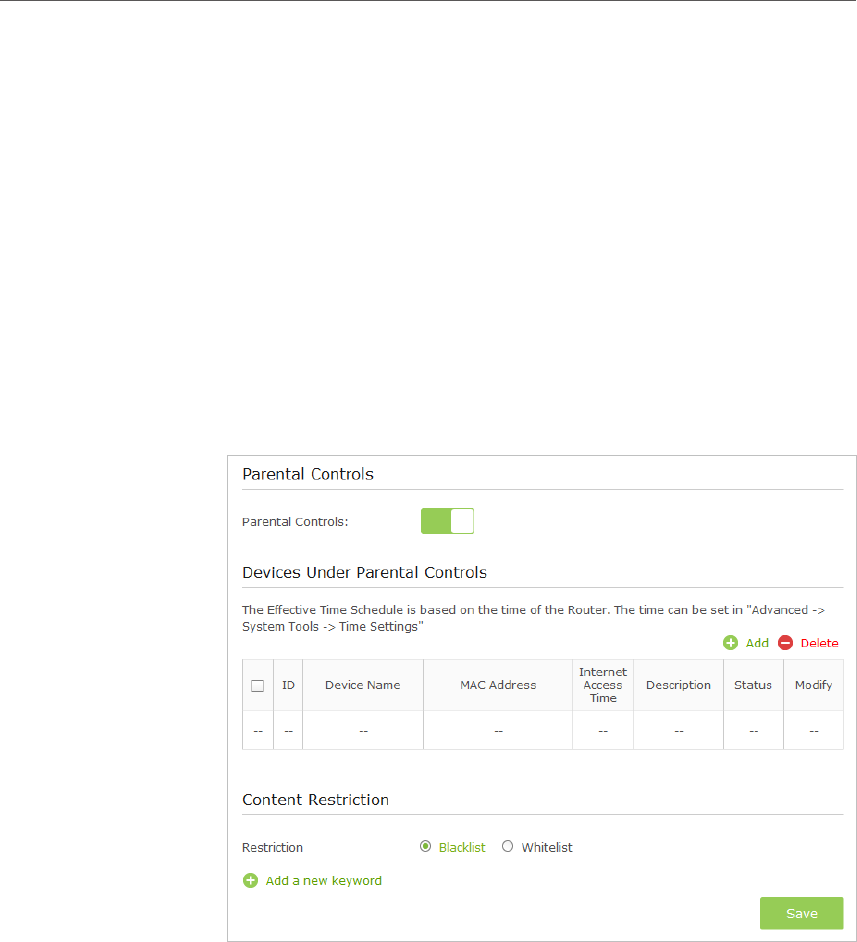
44
Chapter 7 Parental Controls
Control what types of websites my children or other home
network users can visit and even the times of day they are
allowed to access the Internet.
For example, I want to allow my children’s devices (e.g. a
computer or a tablet) to access only www.tp-link.com and
Wikipedia.org from 18:00 (6PM) to 22:00 (10PM) at the weekend
and not other times.
1. Visit http://tplinkwifi.net, and log in with the username and
password you set for the router.
2. Go to Basic or Advanced > Parental Controls and enable
Parental Controls.
3. Click Add.
4. Click View Existing Devices, and select the access device. Or,
enter the Device Name and MAC Address manually.
I want to:I want
How can I
do that?
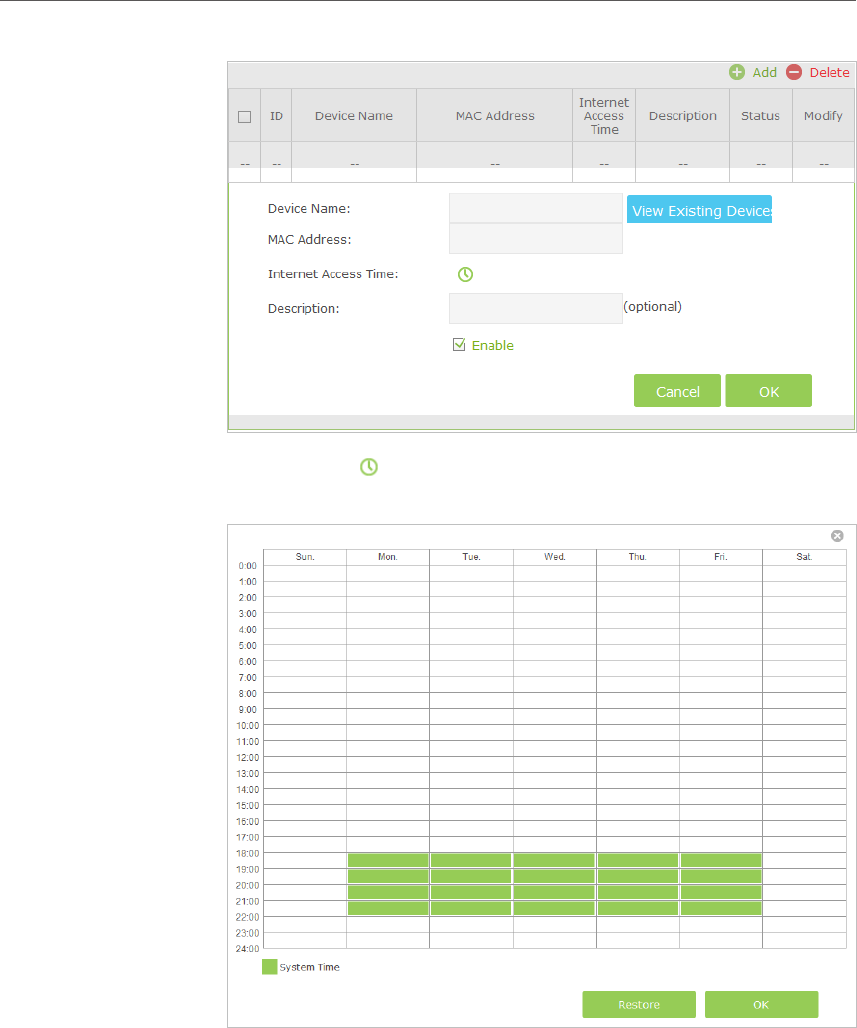
45
Chapter 7 Parental Controls
5. Click the icon to set the Internet Access Time. Drag the
cursor over the appropriate cell(s) and click OK.
6. Enter a Description for the entry. Keep the Enable This Entry
checkbox available. Click OK.
7. Select the restriction policy.
1 ) In Blacklist mode, the controlled devices cannot access
any websites containing the specified keywords during
the Internet Access Time period.
2 ) In Whitelist mode, the controlled devices can only access
websites containing the specified keywords during the
Internet Access Time period.
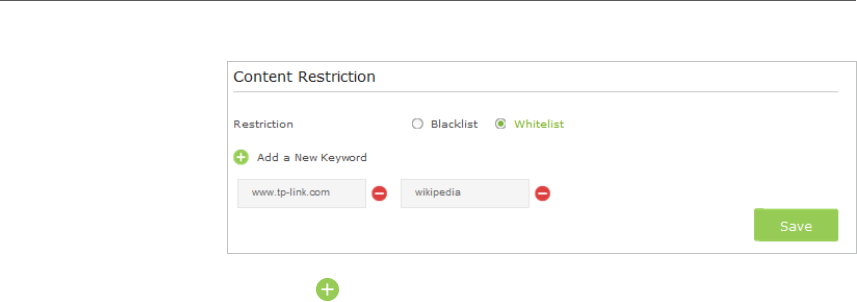
46
Chapter 7 Parental Controls
8. Click Add a new keyword to Block. You can add up to 32
keywords for either Blacklist or Whitelist. Below are some
sample entries to allow access.
1 ) Enter a web address (e.g. wikipedia.org) or a web address
keyword (e.g. wikipedia) to only allow or block access to
the websites containing that keyword.
2 ) Specify the domain suffix (eg. .edu or .org) to allow access
only to the websites with that suffix.
3 ) If you wish to block all Internet browsing access, do not
add any keyword to the Whitelist.
9. Enter a keyword or a website and click Save.
Now you can control your children’s Internet access according
to your needs.
Done!

Chapter 8
Bandwidth Control
The Bandwidth Control feature is used to fully utilize your limit bandwidth and optimize
the load respectively. With this feature enabled, you can assign a specific minimum or
maximum bandwidth for each computer, thus minimizing the impact caused when the
connection is under heavy load.
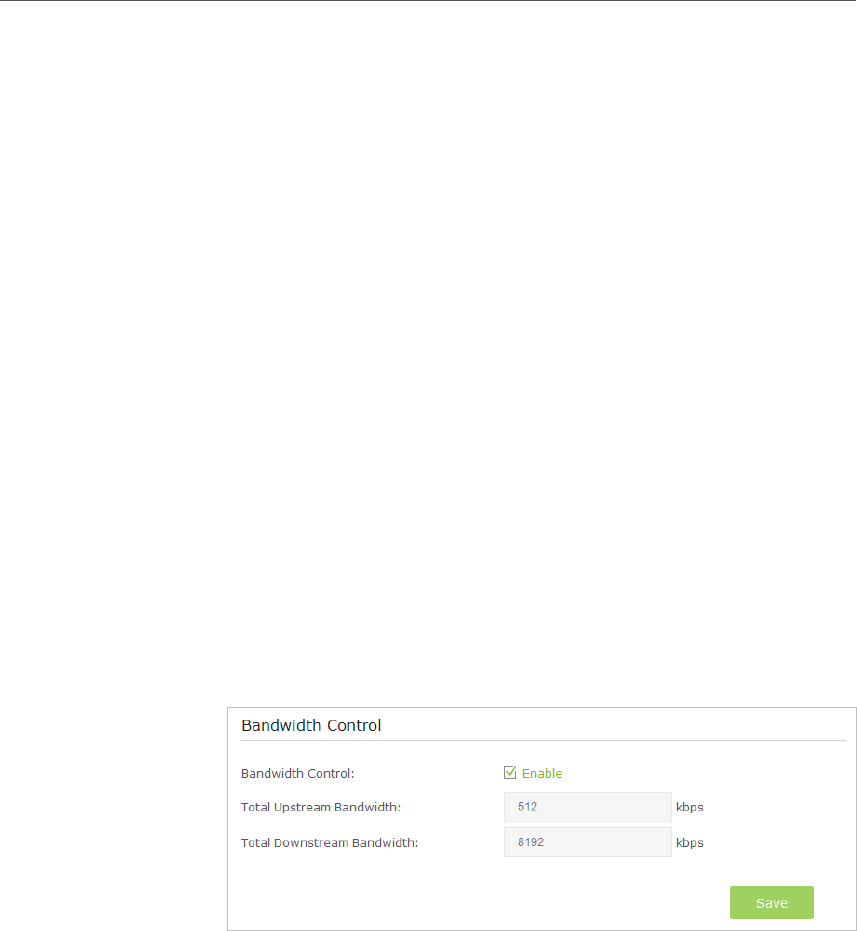
48
Chapter 8 Bandwidth Control
Use an independent bandwidth and enjoy a good Internet
experience without being affected by other users who are
sharing the same router.
For example, my roommate and I share 512Kbps Upstream
Bandwidth and 8Mbps Downstream Bandwidth via this router,
she likes to watch live show and play online games, which may
take up much bandwidth. I don’t want to be affected, so we
agree to equally distribute the bandwidth. Our IP addresses are
192.168.0.101 and 192.168.0.110.
To use the bandwidth control feature, you’d better set static IP
Address on each computer to be controlled or configure Address
reservation on the router in order to manage easily. About how
to configure address reservation, please refer to To reserve an IP
address for a specified client device.
1. Visit http://tplinkwifi.net, and log in with the username and
password you set for the router.
2. Go to Advanced > Bandwidth Control page.
3. Enable Bandwidth Control.
4. Enter the Total Upstream Bandwidth and the Total Downstream
Bandwidth given by your ISP. (1Mbps=1024Kbps). Click Save
to save the settings.
5. Click Add to add controlling rules for each computer
respectively.
I want to:
Tips:
How can I
do that?
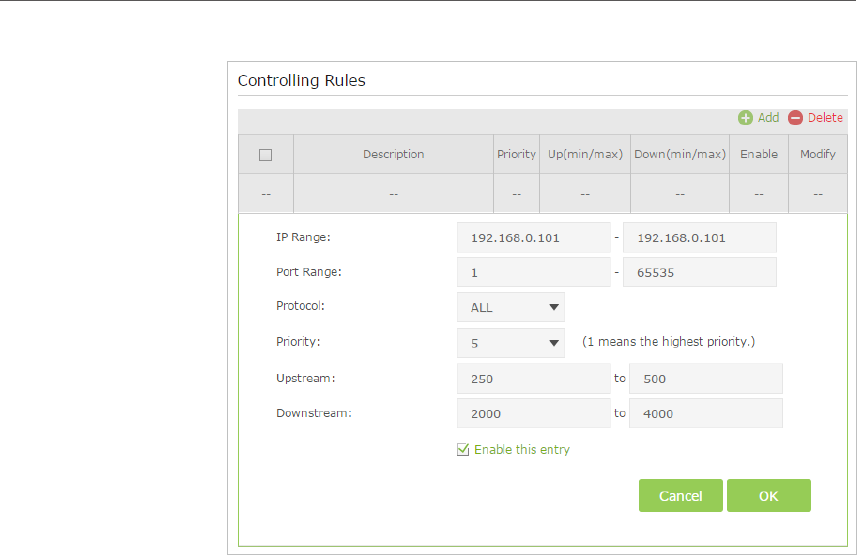
49
Chapter 8 Bandwidth Control
1 ) IP Range: Enter the IP address. The field can be single IP
address or IP address range according to your demands.
When you configure the single IP address, the computer
with this IP address will get independent given
bandwidth. When you configure the IP address range, all
computers in the range will share the given bandwidth.
2 ) Port Range: Keep the default settings. The default port
range of TCP protocol or UDP protocol is from 1 to 65535.
3 ) Protocol: Keep the default setting. Or you can choose the
TCP protocol or UDP protocol or both of them.
4 ) Priority: Keep the default setting. You can change the
value if you want to first guarantee the bandwidth for
one computer. The smaller value has the higher priority.
5 ) Upstream/Downstream: Enter the bandwidth according
to your division.
6 ) Check to enable this entry and click OK to save the
settings.
6. Follow the steps above to add a rule for the other computer.
And then you will get the following table.

50
Chapter 8 Bandwidth Control
Now you and your roommate have an independent bandwidth.
Done!

Chapter 9
Network Security
This chapter guides you on how to protect your home network from cyber attacks
and unauthorized users by implementing these three network security functions. You
can protect your home network against DoS (Denial of Service) attacks from flooding
your network with server requests using DoS Protection, block or allow specific client
devices to access your network using Access Control, or you can prevent ARP spoofing
and ARP attacks using IP & MAC Binding function.
This chapter contains the following sections:
• Protect the Network from Cyber Attacks
• Access Control
• IP & MAC Binding
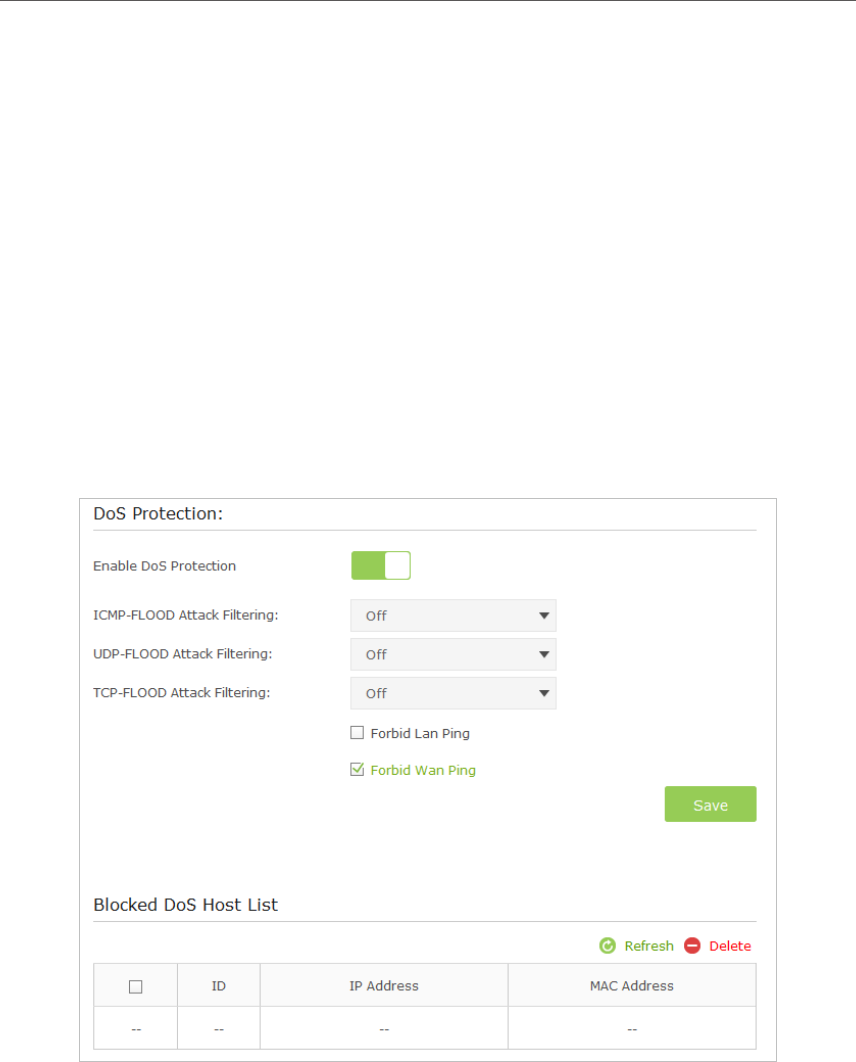
52
Chapter 9 Network Security
9. 1. Protect the Network from Cyber Attacks
The SPI (Stateful Packet Inspection) Firewall and DoS (Denial of Service) Protection
protect the router from cyber attacks.
The SPI Firewall can prevent cyber attacks and validate the traffic that is passing
through the router based on the protocol. This function is enabled by default, and it’s
recommended to keep the default setting.
DoS Protection can protect your home network against DoS attacks from flooding your
network with server requests. Follow the steps below to configure DoS Protection.
1. Visit http://tplinkwifi.net, and log in with the username and password you set for
the router.
2. Go to Advanced > Security > Settings.
3. Enable DoS Protection.
4. Set the level (Off, Low, Middle or High) of protection for ICMP-FLOOD Attack
Filtering, UDP-FlOOD Attack Filtering and TCP-SYN-FLOOD Attack Filtering.
• ICMP-FLOOD Attack Filtering - Enable to prevent the Internet Control Message
Protocol (ICMP) flood attack.
• UDP-FlOOD Attack Filtering - Enable to prevent the User Datagram Protocol
(UDP) flood attack.

53
Chapter 9 Network Security
• TCP-SYN-FLOOD Attack Filtering - Enable to prevent the Transmission Control
Protocol-Synchronize (TCP-SYN) flood attack.
Tips:
The level of protection is based on the traffic packets number. The protection will be triggered immediately
when the number of packets exceeds the preset threshold value (the value can be set on Advanced > System
Tools > System Parameters > DoS Protection Level Settings), and the vicious host will be displayed in the Blocked
DoS Host List.
5. Select Ignore Ping Packet From WAN Port if you want to ignore the ping packets
from WAN port.
6. Select Forbid Ping Packet From LAN Port if you want to ignore the ping packets
from LAN port.
7. Click Save to make the settings effective.
9. 2. Access Control
Access Control is used to block or allow specific client devices to access your network
(via wired or wireless) based on a list of blocked devices (Blacklist) or a list of allowed
devices (Whitelist).
Block or allow specific client devices to access my network (via
wired or wireless).
1. Visit http://tplinkwifi.net, and log in with the username and
password you set for the router.
2. Go to Advanced > Security > Access Control.
I want to:
How can I
do that?
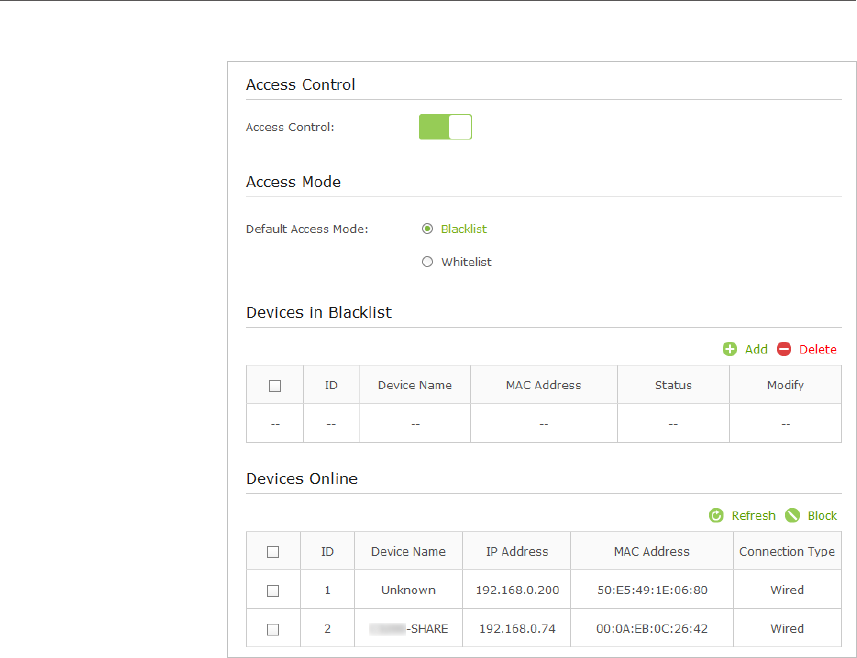
54
Chapter 9 Network Security
3. Enable Access Control.
4. Select the access mode to either block (recommended) or
allow the device(s) in the list.
To block specific device(s)
1 ) Select Blacklist.
2 ) Select the device(s) to be blocked in the Devices Online
table.
3 ) Click Block above the Devices Online table. The selected
devices will be added to Devices in Blacklist automatically.
To allow specific device(s)
1 ) Select Whitelist and click Save.
2 ) Click Add.
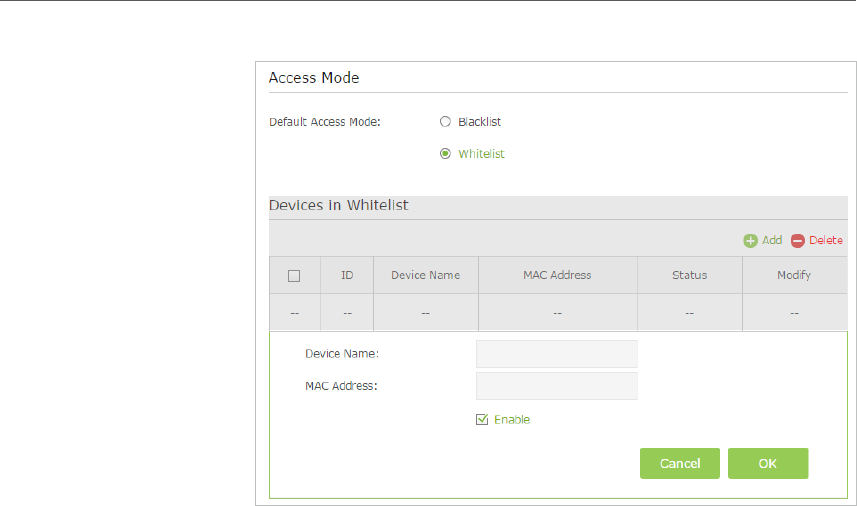
55
Chapter 9 Network Security
3 ) Enter the Device Name and MAC Address (You can copy
and paste the information from the following list if the
device is connected to your network).
4 ) Click OK.
Now you can block or allow specific client devices to access your
network (via wired or wireless) using the Blacklist or Whitelist.
9. 3. IP & MAC Binding
IP & MAC Binding, namely, ARP (Address Resolution Protocol) Binding, is used to bind
network device’s IP address to its MAC address. This will prevent ARP Spoofing and
other ARP attacks by denying network access to an device with matching IP address in
the Binding list, but unrecognized MAC address.
Prevent ARP spoofing and ARP attacks.
1. Visit http://tplinkwifi.net, and log in with the username and
password you set for the router.
2. Go to Advanced > Security > IP & MAC Binding.
3. Enable IP & MAC Binding.
Done!
I want to:
How can I
do that?
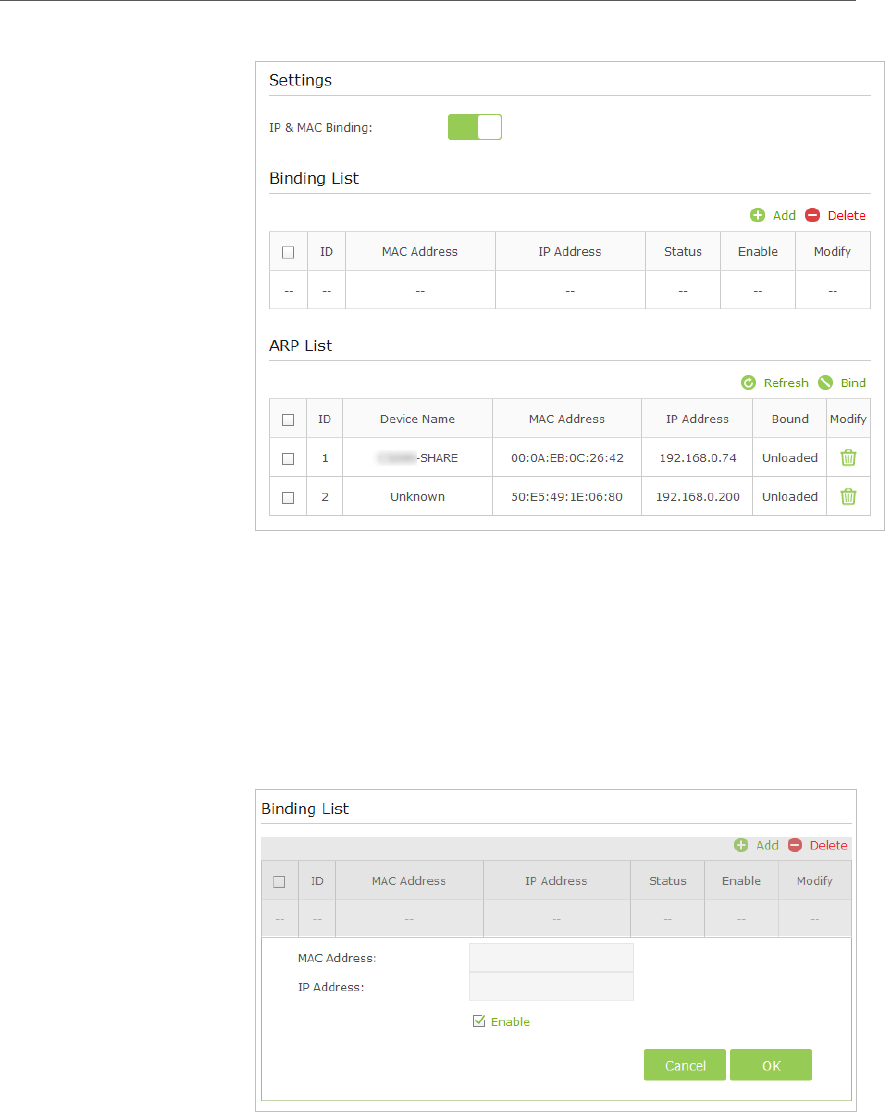
56
Chapter 9 Network Security
4. Bind your device(s) according to your need.
To bind the connected device(s)
1 ) Select the device(s) to be bound in the ARP List.
2 ) Click Bind to add to the Binding List.
To bind the unconnected device
1 ) Click Add.
2 ) Enter the MAC address and IP address that you want to
bind.
3 ) Select the checkbox to enable the entry and click OK.
Now you don’t need to worry about ARP spoofing and ARP
attacks.
Done!

Chapter 10
NAT Forwarding
Router’s NAT (Network Address Translation) feature makes the devices in the LAN use
the same public IP address to communicate in the Internet, which protect the local
network by hiding IP addresses of the devices. However, it also brings about the
problem that external host cannot initiatively communicate with the specified device
in the local network.
With forwarding feature the router can penetrate the isolation of NAT and allows the
external hosts in the Internet to initiatively communicate with the devices in the local
network, thus to realize some special functions.
TP-LINK router includes four forwarding rules. If two or more rules are set, the priority
of implementation from high to low is Virtual Servers, Port Triggering, UPNP and DMZ.
This chapter contains the following sections:
• Share Local Resources in the Internet by Virtual Server
• Open Ports Dynamically by Port Triggering
• Make Applications Free from Port Restriction by DMZ
• Make Xbox Online Games Run Smoothly by UPnP

58
Chapter 10 NAT Forwarding
10. 1. Share Local Resources in the Internet by Virtual
Server
When you build up a server in the local network and want to share it on the Internet,
Virtual Server can realize the service and provide it to the Internet users. At the same
time virtual server can keep the local network safe as other services are still invisible
from the Internet.
Virtual server can be used for setting up public services in your local network, such as
HTTP, FTP, DNS, POP3/SMTP and Telnet. Different service uses different service port.
Port 80 is used in HTTP service, port 21 in FTP service, port 25 in SMTP service and port
110 in POP3 service. Please verify the service port number before the configuration.
Share my personal website I’ve built in local network with my
friends through the Internet.
For example, the personal website has been built in my home
PC (192.168.0.100). I hope that my friends in the Internet can
visit my website in some way. The PC is connected to the router
with the WAN IP address 218.18.232.154.
Router
WAN: 218.18.232.154
LAN
Home
Personal Website
1. Assign a static IP address to your PC, for example
192.168.0.100.
2. Visit http://tplinkwifi.net, and log in with the username and
password you set for the router.
3. Go to Advanced > NAT Forwarding > Virtual Servers, click Add.
4. Click View Existing Services, and select HTTP. The external
port, internal port and protocol will be automatically filled
with contents. Enter the PC’s IP address 192.168.0.100 in the
Internal IP field.
5. Click OK to save the settings.
I want to:
How can I
do that?
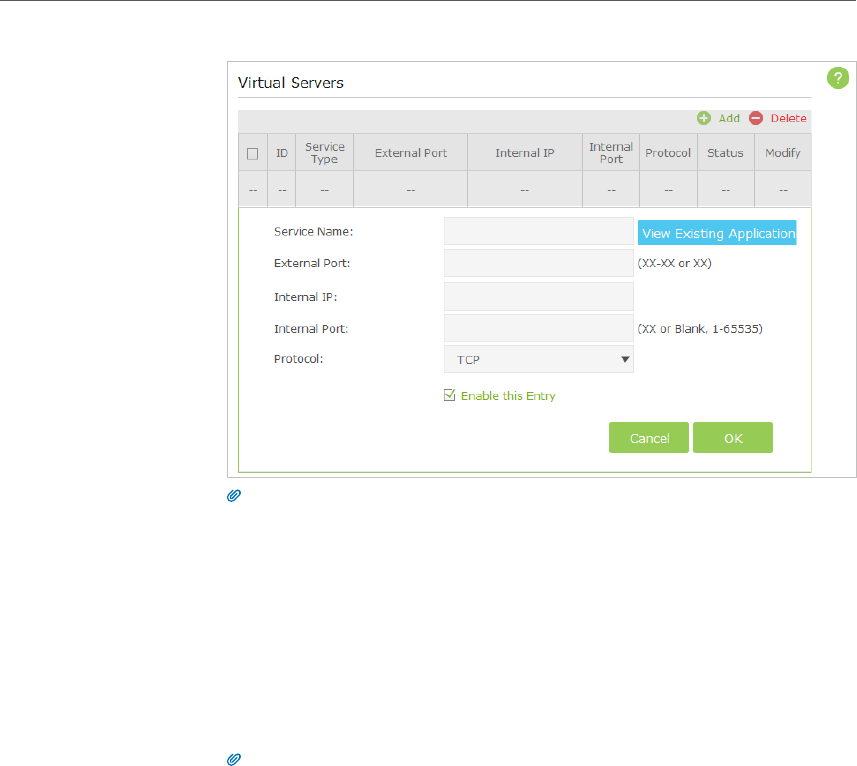
59
Chapter 10 NAT Forwarding
Tips:
1. It is recommended to keep the default settings of Internal Port and Protocol if you
are not clear about which port and protocol to use.
2. If the service you want to use is not in the Service Type, you can enter the
corresponding parameters manually. You should verify the port number that the
service need.
3. You can add multiple virtual server rules if you want to provide several services in
a router. Please note that the External Port should not be overlapped.
Users in the Internet can enter http:// WAN IP (in this example:
http:// 218.18.232.154) to visit your personal website.
Tips:
1. WAN IP should be a public IP address. For the WAN IP is assigned dynamically by
ISP, it is recommended to apply and register a domain name for the WAN refer to
12. 4. Set Up a Dynamic DNS Service Account. Then you can use http:// domain name
to visit the website.
2. If you have changed the default External Port, you should use http:// WAN IP:
External Port or http:// domain name: External Port to visit the website.
10. 2. Open Ports Dynamically by Port Triggering
Port triggering can specify a triggering port and its corresponding external ports.
When a host in the local network initiates a connection to the triggering port, all the
external ports will be opened for subsequent connections. The router can record the IP
address of the host. When the data from the Internet return to the external ports, the
router can forward them to the corresponding host. Port triggering is mainly applied
to online games, VoIPs and video players. Common applications include MSN Gaming
Zone, Dialpad and Quick Time 4 players, etc.
Follow the steps below to configure the port triggering rules:
1. Visit http://tplinkwifi.net, and log in with the username and password you set for the
router.
Done!
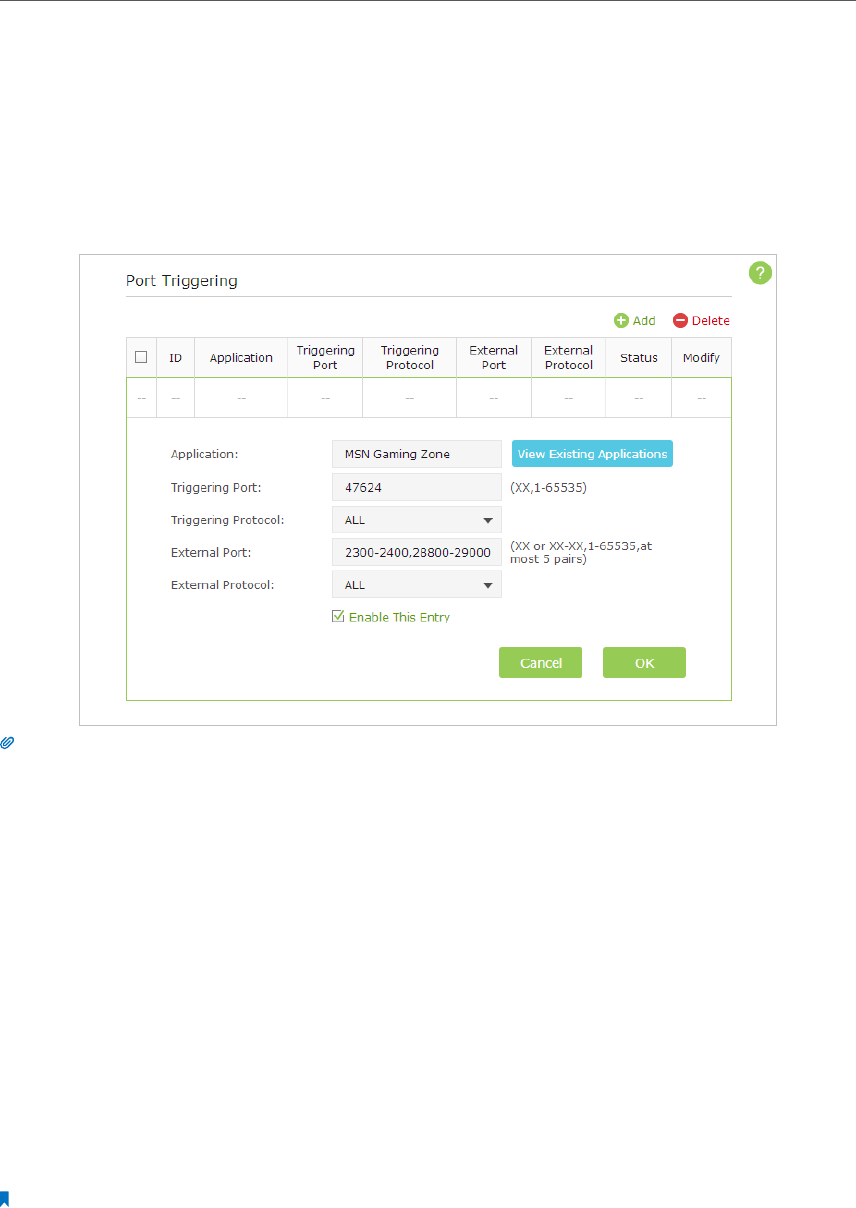
60
Chapter 10 NAT Forwarding
2. Go to Advanced > NAT Forwarding > Port Triggering and click Add.
3. Click View Existing Applications, and select the desired application. The external port,
internal port and protocol will be automatically filled with contents. The following
picture takes application MSN Gaming Zone as an example.
4. Click OK to save the settings.
Tips:
1. You can add multiple port triggering rules according to your network need.
2. If the application you need is not listed in the Existing Applications list, please enter the parameters manually.
You should verify the external ports the application uses first and enter them into External Port field according
to the format the page displays.
10. 3. Make Applications Free from Port Restriction by
DMZ
When a PC is set to be a DMZ (Demilitarized Zone) host in the local network, it is totally
exposed to the Internet, which can realize the unlimited bidirectional communication
between internal hosts and external hosts. The DMZ host becomes a virtual server with
all ports opened. When you are not clear about which ports to open in some special
applications, such as IP camera and database software, you can set the PC to be a DMZ
host.
Note:
DMZ is more applicable in the situation that users are not clear about which ports to open. When it is enabled, the
DMZ host is totally exposed to the Internet, which may bring some potential safety hazard. If DMZ is not in use,
please disable it in time.
Make the home PC join the Internet online game without port
restriction.
I want to:
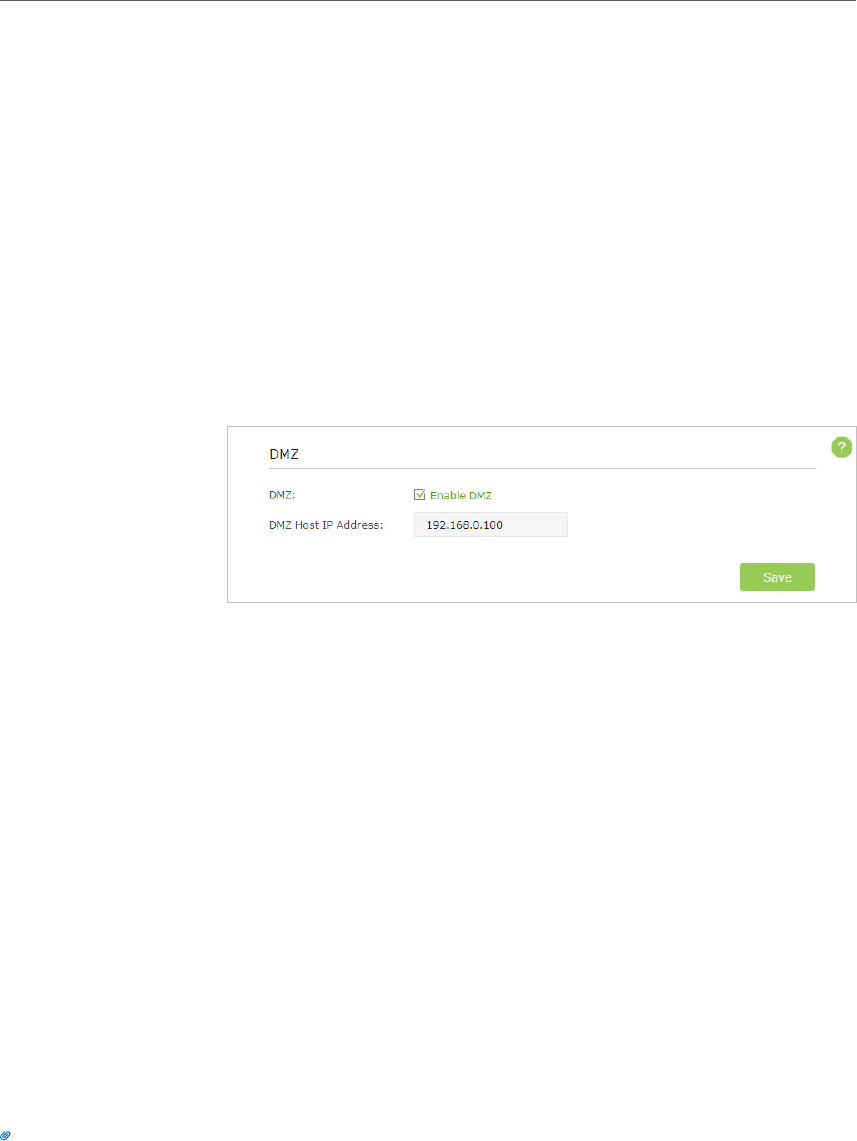
61
Chapter 10 NAT Forwarding
For example, due to some port restriction, when playing the
online games, you can login normally but cannot join a team
with other players. To solve this problem, set your PC as a DMZ
with all ports opened.
1. Assign a static IP address to your PC, for example
192.168.0.100.
2. Visit http://tplinkwifi.net, and log in with the username and
password you set for the router.
3. Go to Advanced > NAT Forwarding > DMZ and select the
checkbox to enable DMZ.
4. Enter the IP address 192.168.0.100 in the DMZ Host IP
Address filed.
5. Click Save to save the settings.
The configuration is completed. You’ve set your PC to a DMZ
host and now you can make a team to game with other players.
10. 4. Make Xbox Online Games Run Smoothly by UPnP
UPnP (Universal Plug and Play) protocol allows the applications or host devices
to automatically find the front-end NAT device and send request to it to open the
corresponding ports. With UPnP enabled, the applications or host devices in the
both sides of NAT device can freely communicate with each other realizing the
seamless connection of the network. You may need to enable the UPnP if you want
to use applications for multiplayer gaming, peer-to-peer connections, real-time
communication (such as VoIP or telephone conference) or remote assistance, etc.
Tips:
1. UPnP is enabled by default in this router.
2. Only the application supporting UPnP protocol can use this feature.
3. UPnP feature needs the support of operating system (e.g. Windows Vista/ Windows 7/ Windows 8, etc. Some of
operating system need to install the UPnP components).
For example, when you connect your Xbox to the router which has connected to
the Internet to play online games, UPnP will send request to the router to open the
corresponding ports allowing the following data penetrating the NAT to transmit.
Therefore, you can play Xbox online games without a hitch.
How can I
do that?
Done!
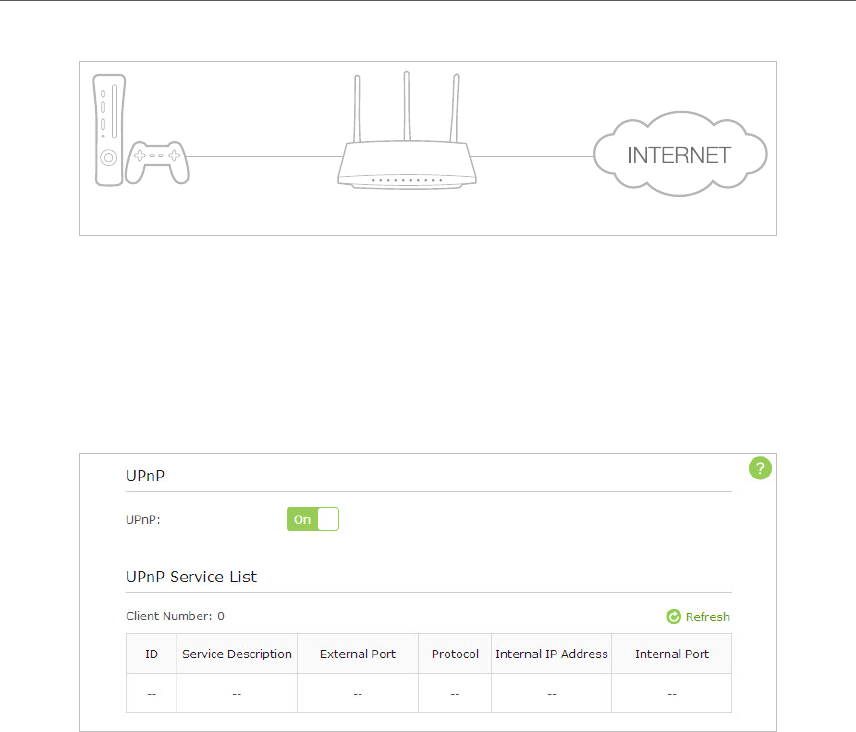
62
Chapter 10 NAT Forwarding
RouterXbox
LAN WAN
If necessary, you can follow the steps to change the status of UPnP.
1. Visit http://tplinkwifi.net, and log in with the username and password you set for the
router;
2. Go to Advanced > NAT Forwarding > UPnP and toggle on or off according to your
needs.

Chapter 11
VPN Server
The VPN (Virtual Private Networking) Server allows you to access your home network in
a secured way through Internet when you are out of home. The router offers two ways
to setup VPN connection: OpenVPN and PPTP (Point to Point Tunneling Protocol) VPN.
OpenVPN is somewhat complex but with greater security and more stable. It is suitable
for restricted environment, such as campus network and company intranet.
PPTP VPN is more easily used and its speed is faster, it’s compatible with most operating
systems and also supports mobile devices. Its security is poor and your packets may be
cracked easily, and PPTP VPN connection may be prevented by some ISP.
Please choose the appropriate VPN server connection type according to your needs.
This chapter contains the following sections:
• Use OpenVPN to Access Your Home Network
• Use PPTP VPN to Access Your Home Network
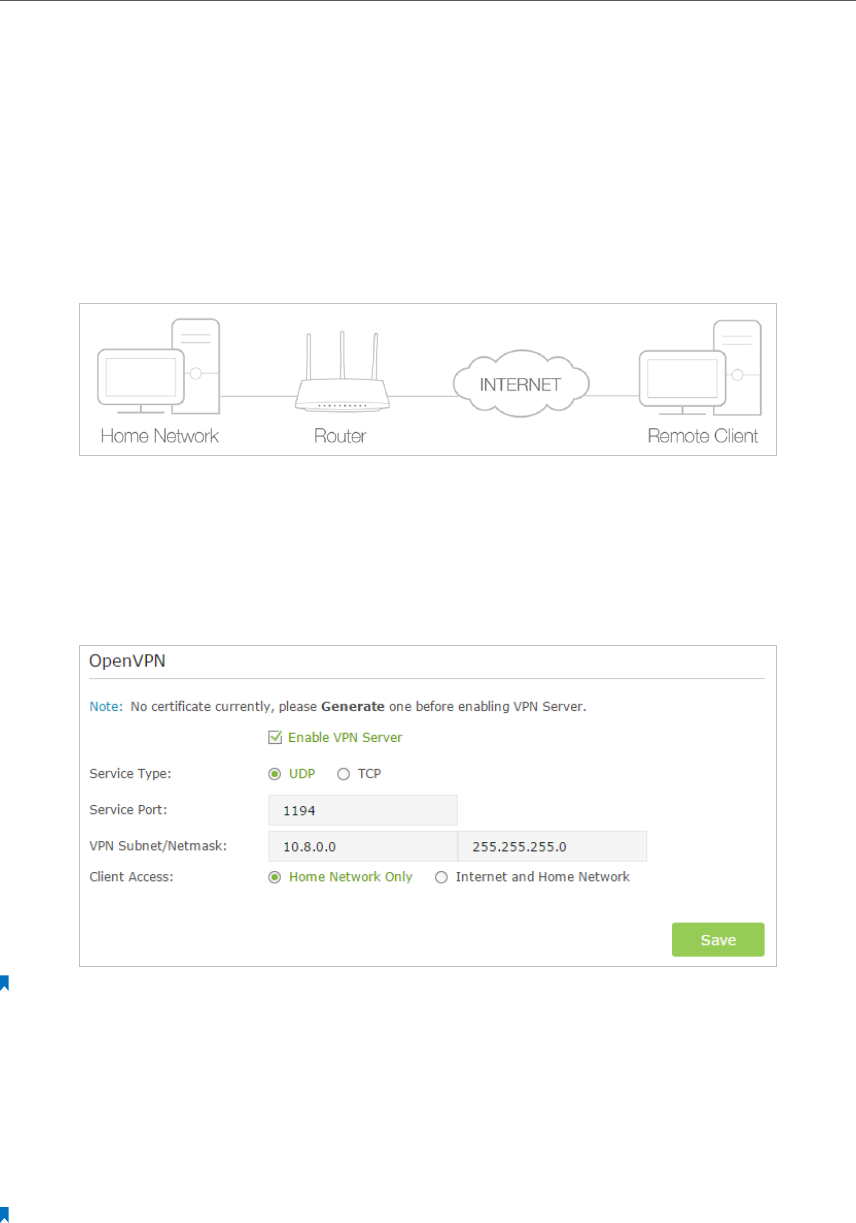
64
Chapter 111 VPN Server
11. 1. Use OpenVPN to Access Your Home Network
In the OpenVPN connection, the home network can act as a server, and the remote
client can access the server through the router which acts as an OpenVPN Server
gateway. To use the VPN feature, you should enable OpenVPN Server on your router,
and install and run VPN client software on the remote client. Please follow the steps
below to set up an OpenVPN connection.
Step1. Set up OpenVPN Server on Your Router
1. Visit http://tplinkwifi.net, and log in with the username and password you‘ve set for
the router.
2. Go to Advanced > VPN Server > OpenVPN. And then Select Enable VPN Server.
Note:
1. Before you enable VPN Server, we recommend you configure Dynamic DNS Service (recommended) or assign a
static IP address for router’s WAN port and synchronize your System Time with Internet.
2. The first time you configure the OpenVPN Server, you may need to Generate a certificate before you enable the
VPN Server.
3. Select the Servive Type (communication protocol) for OpenVPN Server: UDP, TCP.
4. Enter a VPN Service Port to which a VPN client connects, and the port number should
be between 1024 and 65535.
Note:
If you have configured NAT Settings, please make sure the Service Port number is not the same as the external port
of NAT Settings.
5. In VPN Subnet/Netmask field, enter the range of IP addresses that can be leased to
the client by the OpenVPN server.
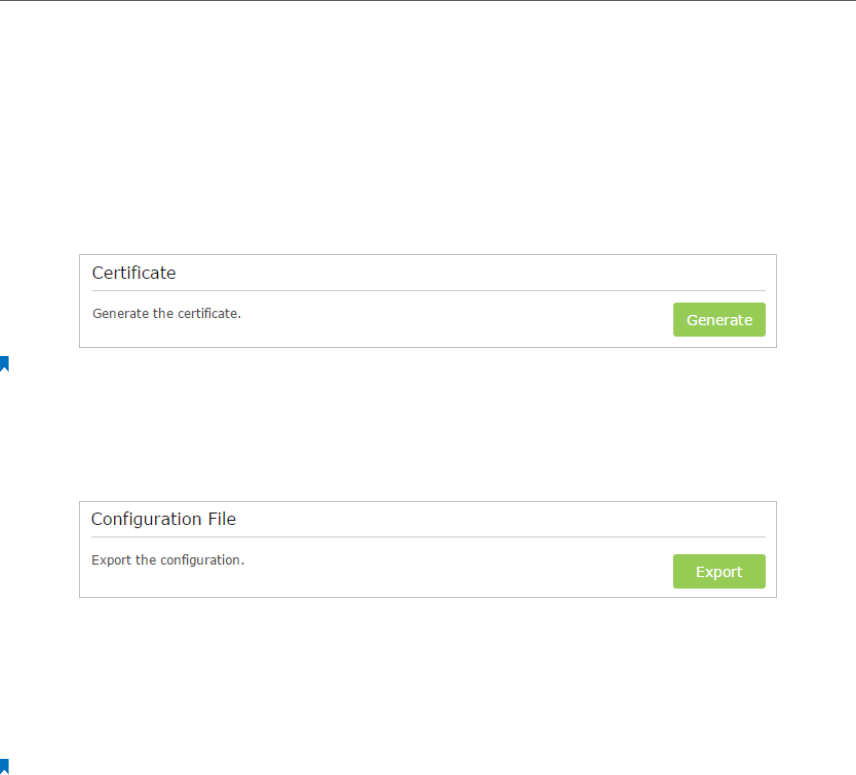
65
Chapter 111 VPN Server
6. Select your Client Access type., select Home Network Only if you only want the
remote client to access your home network, select Internet and Home Network if the
remote client also want to access Internet through VPN Server.
7. Click Save.
8. Click Generate to generate a new certificate.
Note:
If you have already generated one, please skip this step, or click Generate to update the certificate.
9. Click Export to save the OpenVPN configuration file. Remote client will use this
configuration file to access your router.
Step 2. Configure OpenVPN Connection on Your Remote Client
1. Visit http://openvpn.net/index.php/download/community-downloads.html to
download the OpenVPN software, and install it on your client where you want to run
the OpenVPN client utility.
Note:
You need to install the OpenVPN client utility on each client that you plan to use for VPN connections to your router.
Mobile devices should download third-party app from Google Play or APP Store.
2. After the installation, copy the file exporting from your router to OpenVPN client
utility’s “config” folder (for Windows): C:\Program Files\OpenVPN\config. The path is
depending on where the OpenVPN client utility is installed on.
3. Run the OpenVPN client utility and connect it to OpenVPN Server.
11. 2. Use PPTP VPN to Access Your Home Network
PPTP VPN Server is used to create a VPN connection for remote client. To use the VPN
feature, you should enable PPTP VPN Server on your router, and configure the PPTP
connection on the remote client. Please follow the steps below to set up a PPTP VPN
connection.
Step 1. Set up PPTP VPN Server on Your Router
1. Visit http://tplinkwifi.net, and log in with the username and password you’ve set for
the router.
2. Go to Advanced > VPN Server > PPTP VPN. And then select Enable VPN Server.
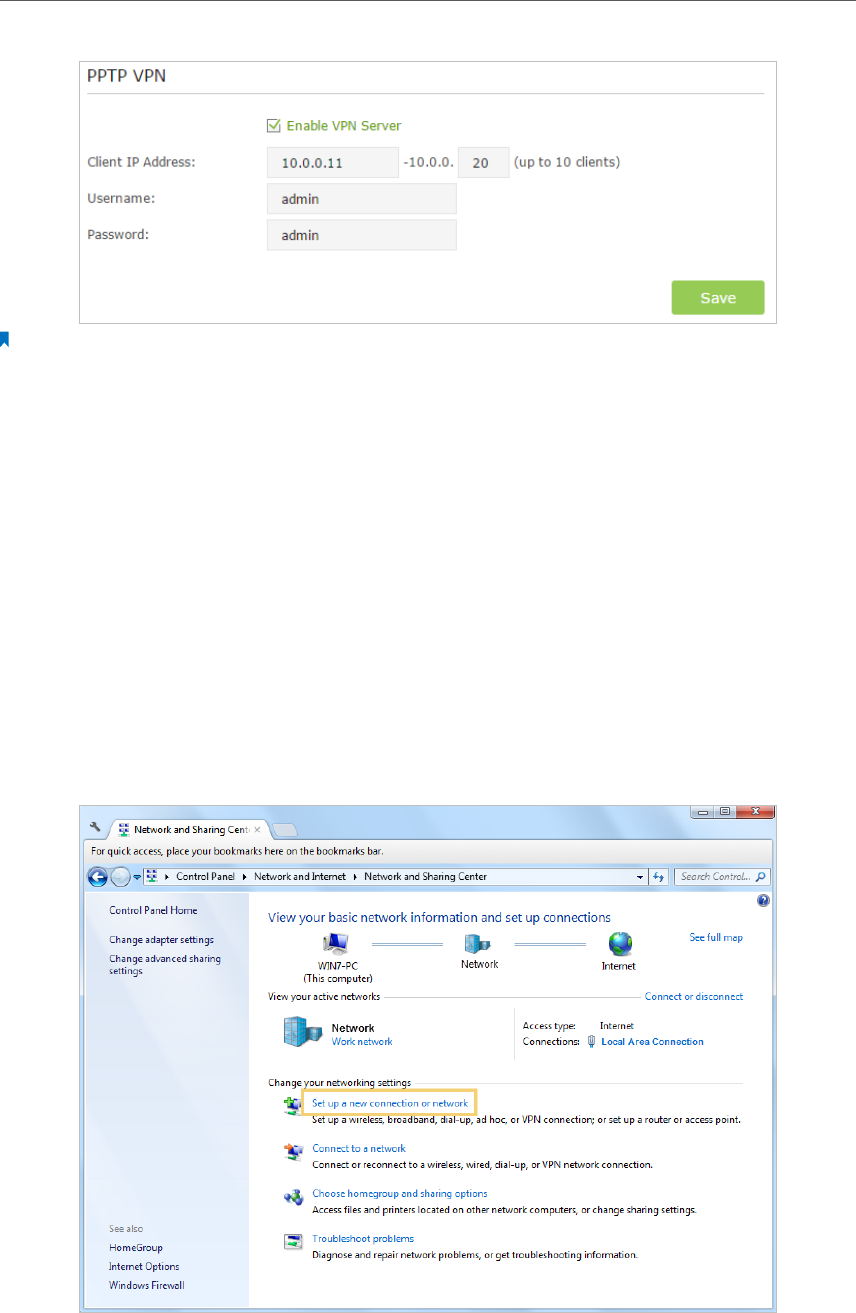
66
Chapter 111 VPN Server
Note:
Before you enable VPN Server, we recommend you configure Dynamic DNS Service (recommended) or assign a
static IP address for router’s WAN port and synchronize your System Time with Internet. If you have configured NAT
Settings, please make sure your external port of NAT settings is not 1723.
3. In the Client IP Address filed, enter the range of IP addresses (up to 10 clients) that
can be leased to the client by the PPTP VPN server.
4. Enter the Username and Password to authenticate clients to the PPTP VPN server.
5. Click Save.
Step 2. Configure PPTP VPN Connection on Your Remote Client
Remote client can use Windows built-in PPTP software or third-party PPTP software to
connect to PPTP Server. Here we use Windows built-in PPTP software as an example.
1. Go to Start > Control Panel > Network and Internet > Network and Sharing Center.
2. Select Set up a new connection or network.
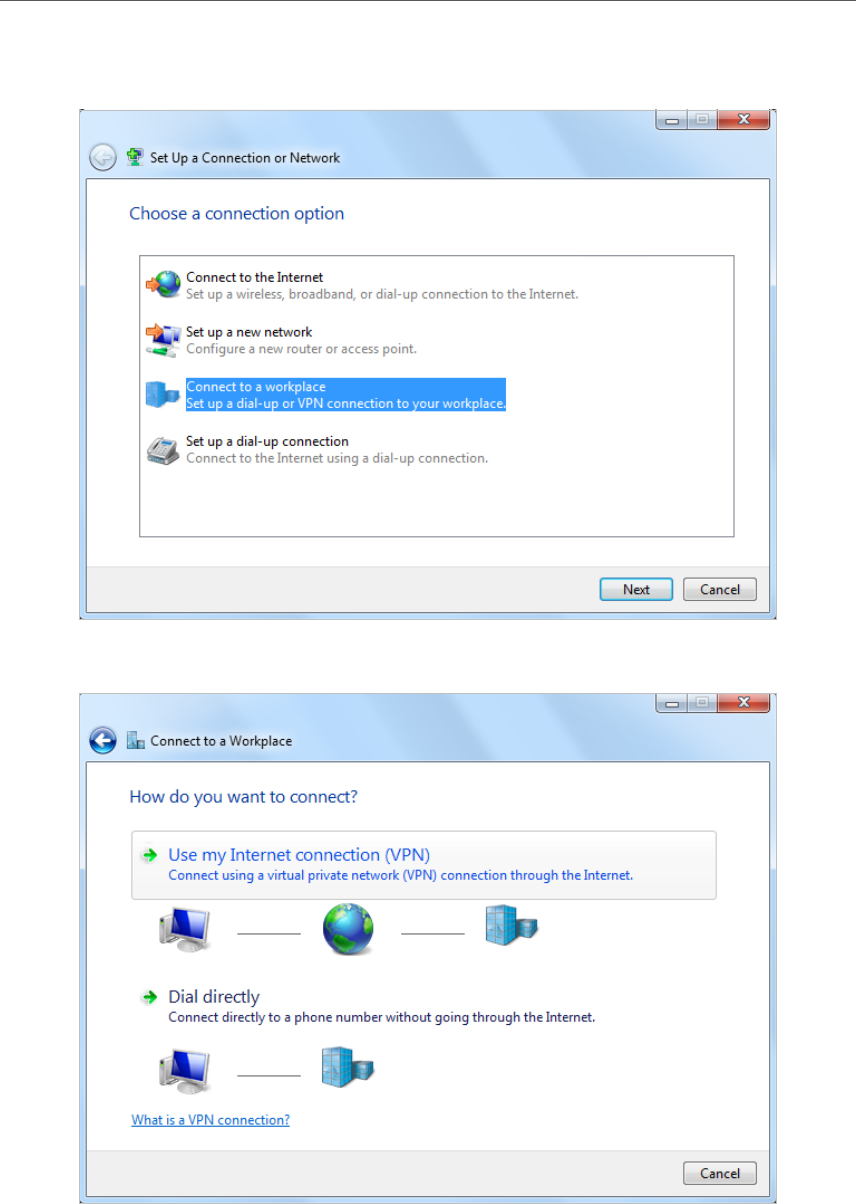
67
Chapter 111 VPN Server
3. Select Connect to a workplace and click Next.
4. Select Use my Internet connection (VPN).
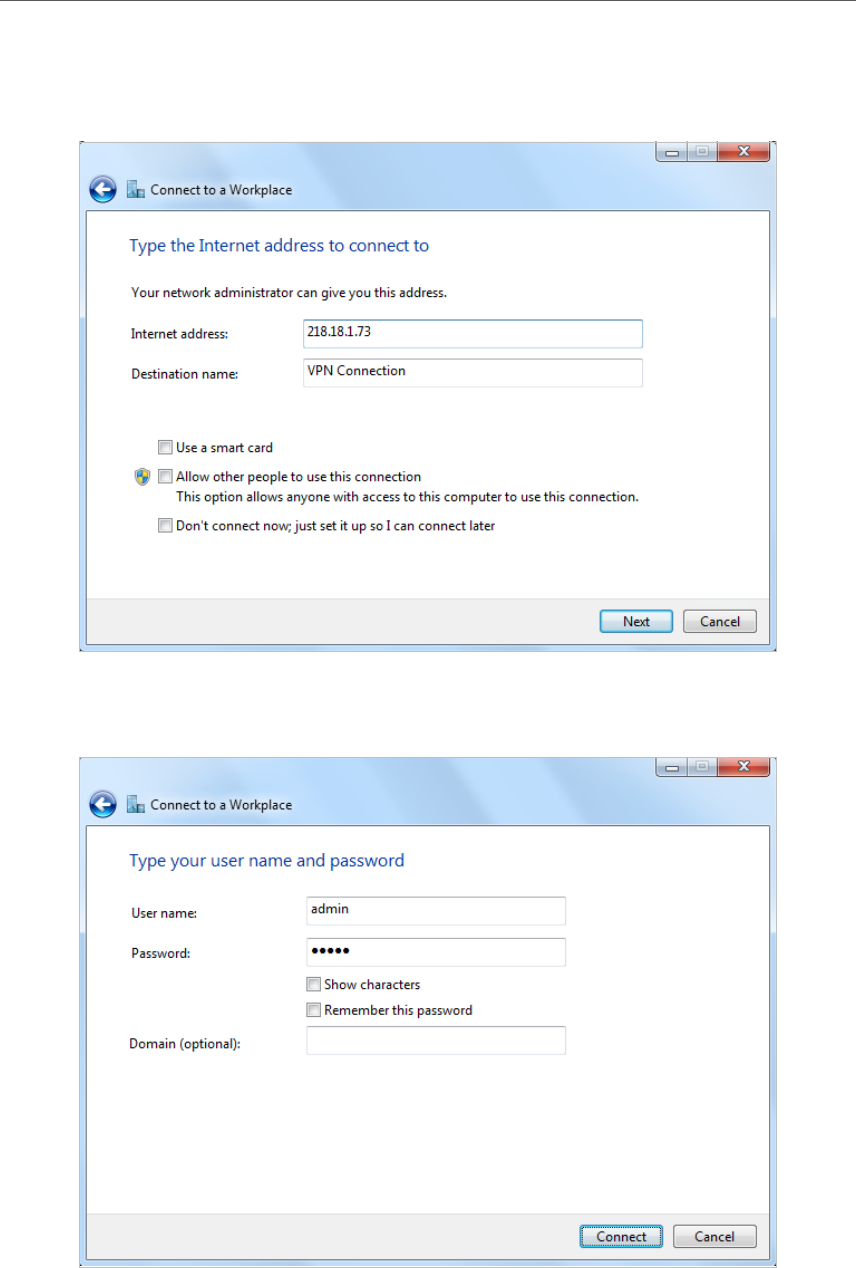
68
Chapter 111 VPN Server
5. Enter the WAN IP address of the router (for example: 218.18.1.73) in the Internet
address field. Click Next.
6. Enter the User name and Password, it’s the username and password you have set on
your router, and click Connect.

69
Chapter 111 VPN Server
7. The PPTP VPN connection is created and ready to use.

Chapter 12
Customize Your Network
Settings
This chapter guides you on how to configure advanced networking features that are
available for this router.
This chapter contains the following sections:
• Change the LAN Settings
• Configure to Support IPTV Service
• Specify DHCP Server Settings
• Set Up a Dynamic DNS Service Account
• Create Static Routes
• Specify Wireless Settings
• Use WPS for Wireless Connection
• Schedule Your Wireless Function
• Set up a VPN Connection
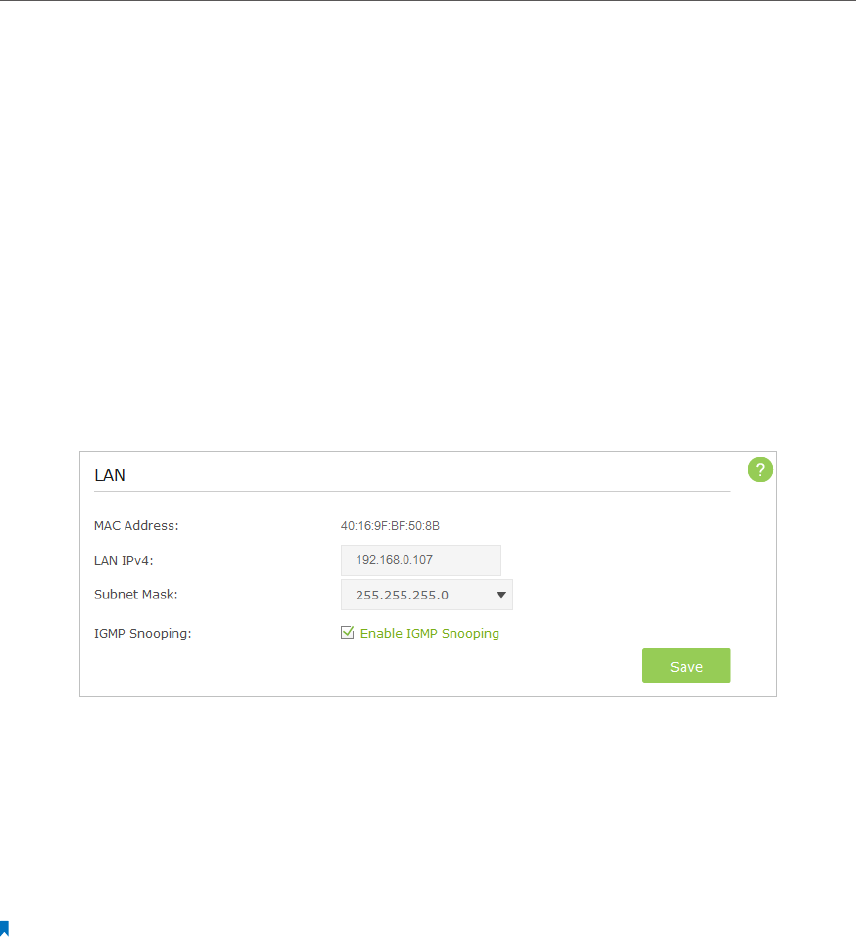
71
Chapter 12 Customize Your Network Settings
12. 1. Change the LAN Settings
The router is preset with a default LAN IP 192.168.0.1, which you can use to log in to its
web-based management page. The LAN IP address together with the Subnet Mask also
defines the subnet that the connected devices are on. If the IP address conflicts with
another device on your local network or your network requires a specific IP subnet, you
can change it.
1. Visit http://tplinkwifi.net, and log in with the username and password you set for the
router.
2. Go to Advanced > Network > LAN page.
3. Type in a new IP address appropriate to your needs.
4. Leave the Subnet Mask as the default settings.
5. Keep IGMP Snooping as enabled by default. IGMP Snooping is the process of listening
to IGMP (Internet Group Management Protocol) network traffic. The function
prevents hosts on a local network from receiving traffic for a multicast group they
have not explicitly joined.
6. Click Save.
Note:
If you have set the Virtual Server, DMZ or DHCP address reservation, and the new LAN IP address is not in the same
subnet with the old one, then you should reconfigure them.
12. 2. Configure to Support IPTV Service
IPTV is the abbreviation of Internet Protocol Television. The service can only be delivered
through the Internet, and our router provides a specific LAN port for IPTV.
By automatically seperating IPTV from Internet surfing, we guarantee you a high quality
of vedio streaming and a high speed of Internet surfing.
Configure the router to enable Internet Protocol Television
(IPTV) Services.
I want to:
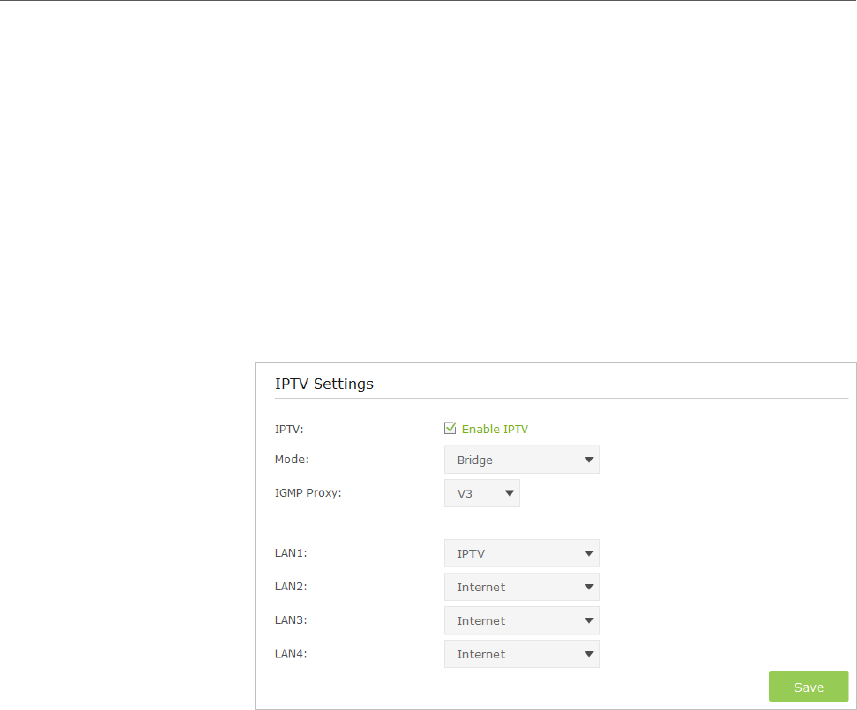
72
Chapter 12 Customize Your Network Settings
For example, I already bought IPTV service, but this service can
only be delivered through the Internet. Therefore, I need to
configure my router first.
1. Visit http://tplinkwifi.net, and log in with the username and
password you set for the router.
2. Go to Advanced > Network > IPTV to open the configuration
page.
3. Configure IPTV settings:
1 ) Select the Enable IPTV check box.
2 ) Select the appropriate Mode according to your ISP. Select
Bridge if your ISP is not listed and no other parameters
are required, and then skip to substep 4. Select Custom if
your ISP is not listed but provides necessary parameters.
3 ) After you have selected a mode, the necessary parameters
are predetermined. You can perform other configuration,
e.g. enter the IPTV Multicast VLAN ID and select the IPTV
Multicast VLAN Priority in Russia mode according to your
ISP.
4 ) Select the IGMP Proxy version, either V2 or V3, according
to the information provided by your ISP.
5 ) For Russia, Singapore-ExStream, Malaysia-Unifi and Malaysia-Maxis mode,
connect device to the predetermined LAN port. For Bridge and Custom
mode, select a LAN port as the IPTV port and connect the set-top box to the
corresponding port.
6 ) Click Save.
Your IPTV setup is done now! You may need other configurations
on your set-top box before enjoying your TV.
How can I
do that?
Done!
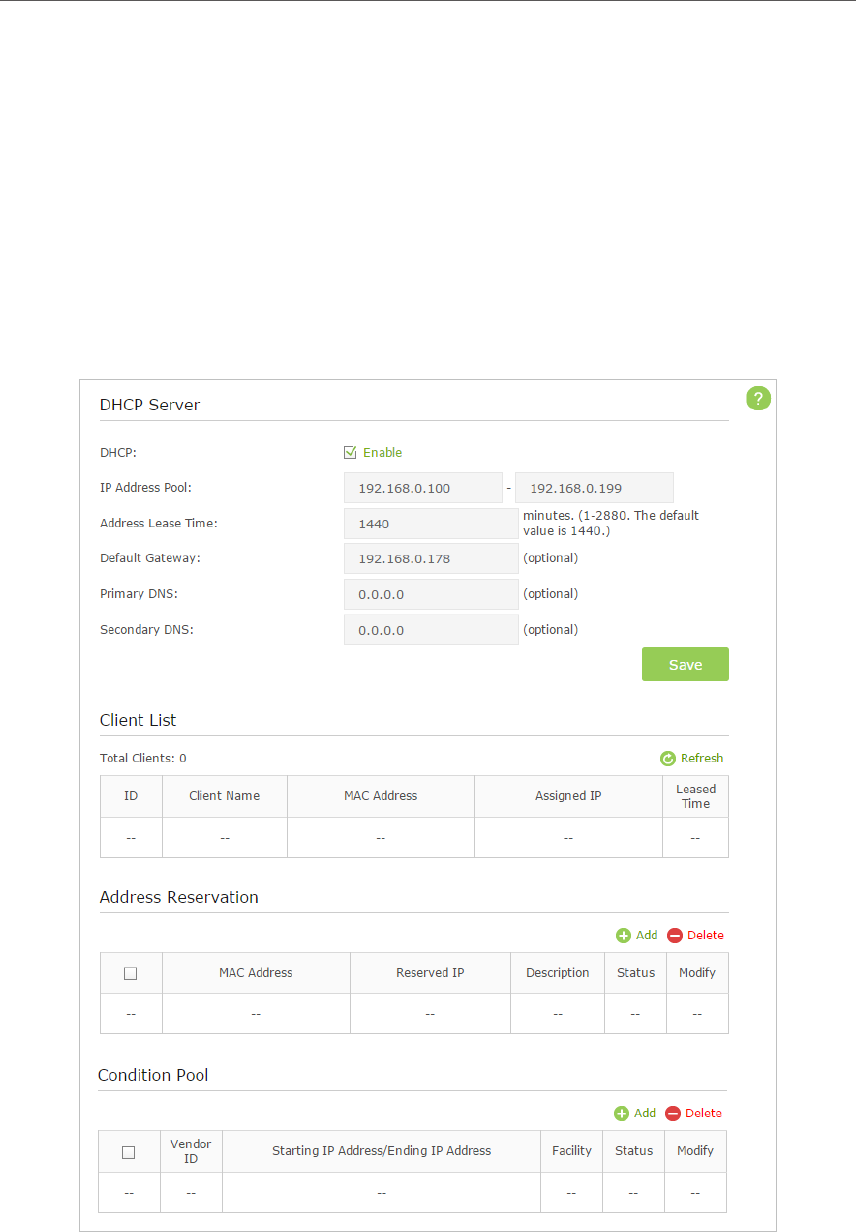
73
Chapter 12 Customize Your Network Settings
12. 3. Specify DHCP Server Settings
By default, the DHCP (Dynamic Host Configuration Protocol) Server is enabled and the
router acts as a DHCP server; it dynamically assigns TCP/IP parameters to client devices
from the IP Address Pool. You can change the settings of DHCP Server if necessary, and
you can reserve LAN IP address for specified client device.
1. Visit http://tplinkwifi.net, and log in with the username and password you set for the
router.
2. Go to Advanced > Network > DHCP Server.
¾To specify the IP address that the router assigns
1. Make sure that the Enable DHCP Server checkbox is selected.
2. Enter the starting and ending IP address in the IP Address Pool.
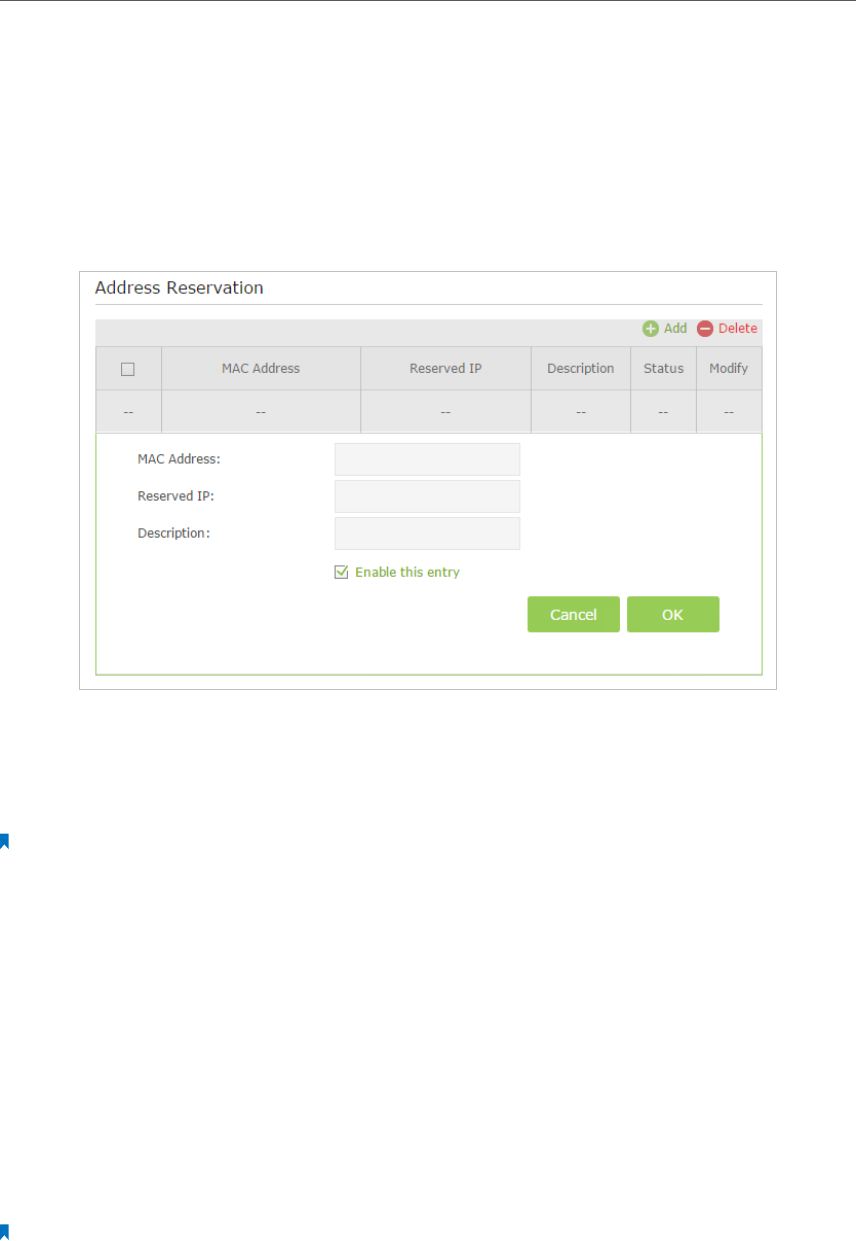
74
Chapter 12 Customize Your Network Settings
3. Enter other parameters if the ISP offers, the Default Gateway is automatically filled,
which is the same as the LAN IP address of the router.
4. Click Save to make the settings effective.
¾To reserve an IP address for a specified client device
1. Click the Add button.
2. Enter the MAC address of the device for which you want to reserve IP address.
3. Specify the IP address which will be reserved by the router.
4. Check to Enable this entry and click OK to make the settings effective.
Note:
You can also appoint IP addresses within a specified range to devices of the same type by using Condition Pool
feature. For example, you can assign IP addresses within the range (192.168.0.50 to192.168.0.80) to Camera devices,
thus facilitating the network management.
12. 4. Set Up a Dynamic DNS Service Account
Most ISPs (Internet service provieders) assign a dynamic IP address to the router and
you can use this IP address to access your router remotely. However, the IP address can
change any time and you don’t know when it changes. In this case, you might need
the DDNS (Dynamic Domain Name Server) feature on the router to allow you and your
friends to access your router and local servers (FTP, HTTP, etc.) using domain name, in
no need of checking and remembering the IP address.
Note: DDNS does not work if the ISP assigns a private Internet IP address (such as 192.168.0.x) to the router.
To set up DDNS, please follow the instructions below:
1. Visit http://tplinkwifi.net, and log in with the username and password you set for the
router.
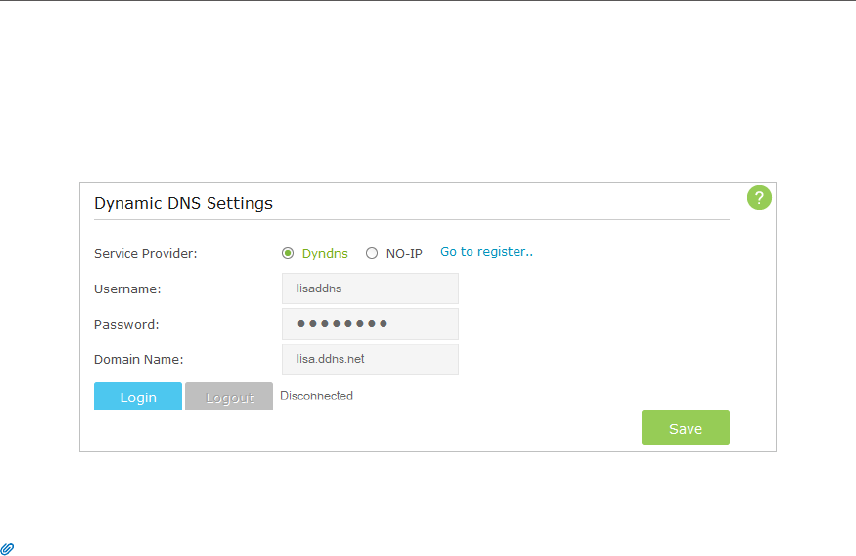
75
Chapter 12 Customize Your Network Settings
2. Go to Advanced > Network > Dynamic DNS.
3. Select the DDNS Service Provider (Dyndns or NO-IP). If you don’t have a DDNS
account, select a service provider and click Go to register.
4. Enter the username, password and domain name of the account.
5. Click Login and click Save.
Tips: If you want to use a new DDNS account, please Logout first, then log in with the new account.
12. 5. Create Static Routes
Static routing is a form of routing that is configured manually by a network administrator
or a user by adding entries into a routing table. The manually-configured routing
information guides the router in forwarding data packets to the specific destination.
Visit multiple networks and multiple servers at the same time.
For example, in a small office, my PC can surf the Internet, but I
also want to visit my company’s network. Now I have a switch and
another router. I connect the devices as shown in the following
figure so that the physical connection between my PC and my
company’s server is achieved. To surf the Internet and visit my
company’s network at the same time, I need to configure the
static routing.
I want to:
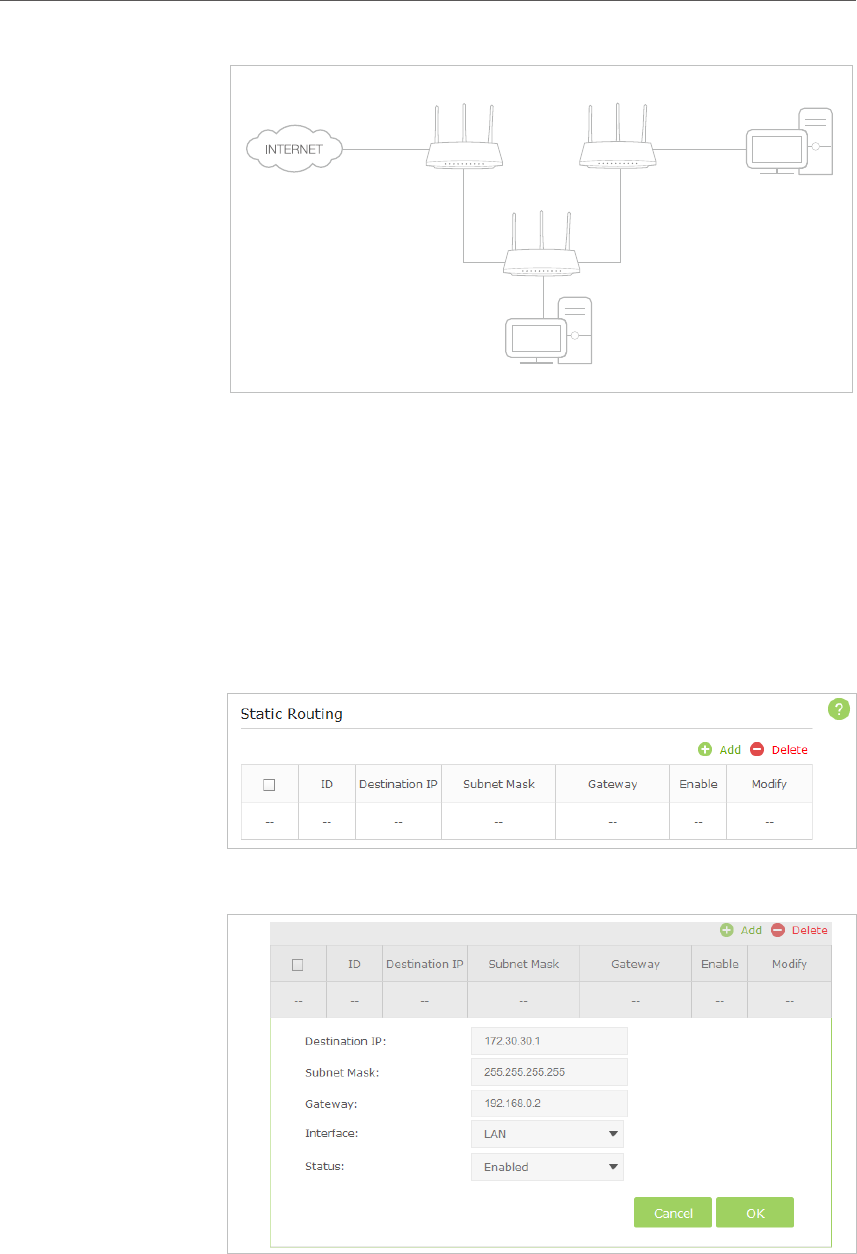
76
Chapter 12 Customize Your Network Settings
PC 1
PC 2
Router 2
Router 1
Router 3
LAN: 192.168.0.1
192.168.0.100
LAN: 192.168.0.2
WAN: 172.30.30.100
172.30.30.1
1. Change the router’s LAN IP addresses to two different IP
addresses on the same subnet. Disable Router 2’s DHCP
function.
2. Visit http://tplinkwifi.net, and log in with the username and
password you set for the router.
3. Go to Network > Advanced Routing.
4. Click Add to add a new static routing entry.
5. Finish the settings according to the following explanations:
Destination IP: The destination IP address that you want to
assign to a static route. This IP address cannot be on the same
subnet with the WAN IP or LAN IP of the router. In the example,
How can I
do that?